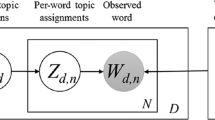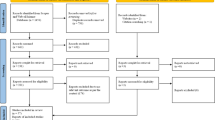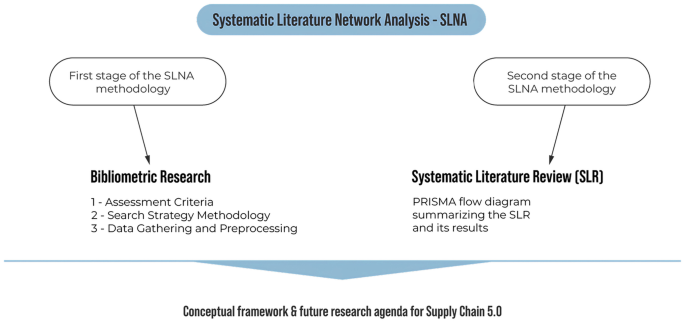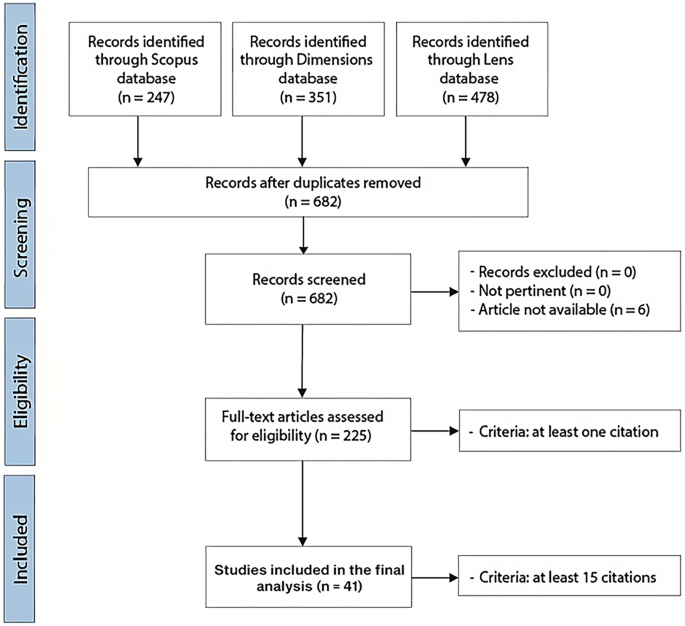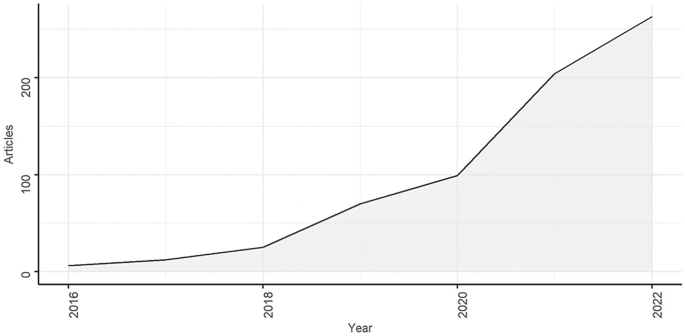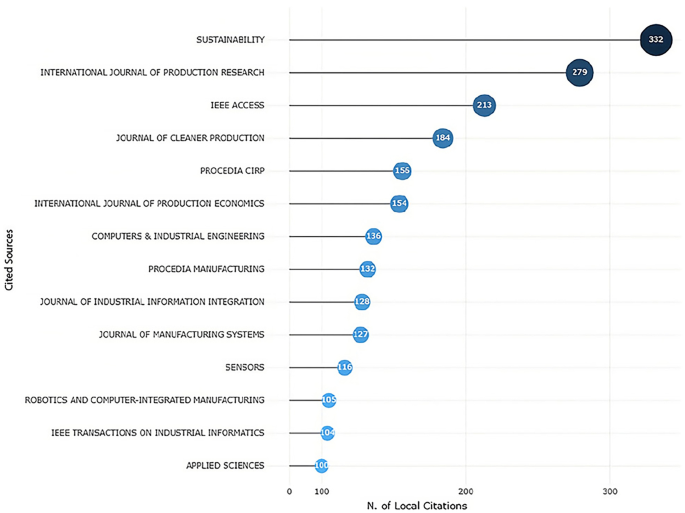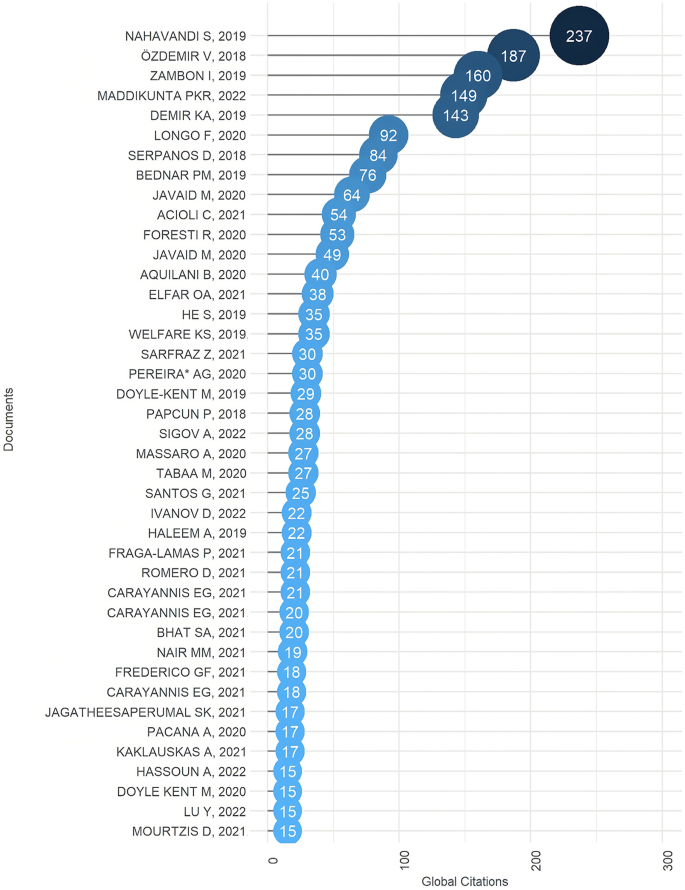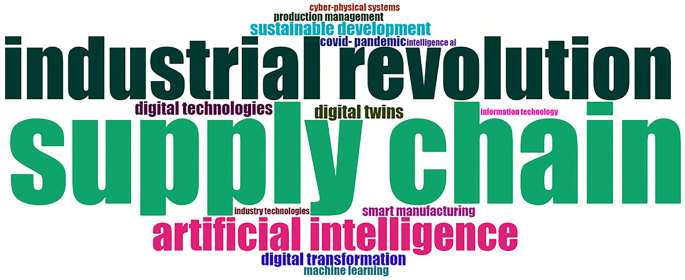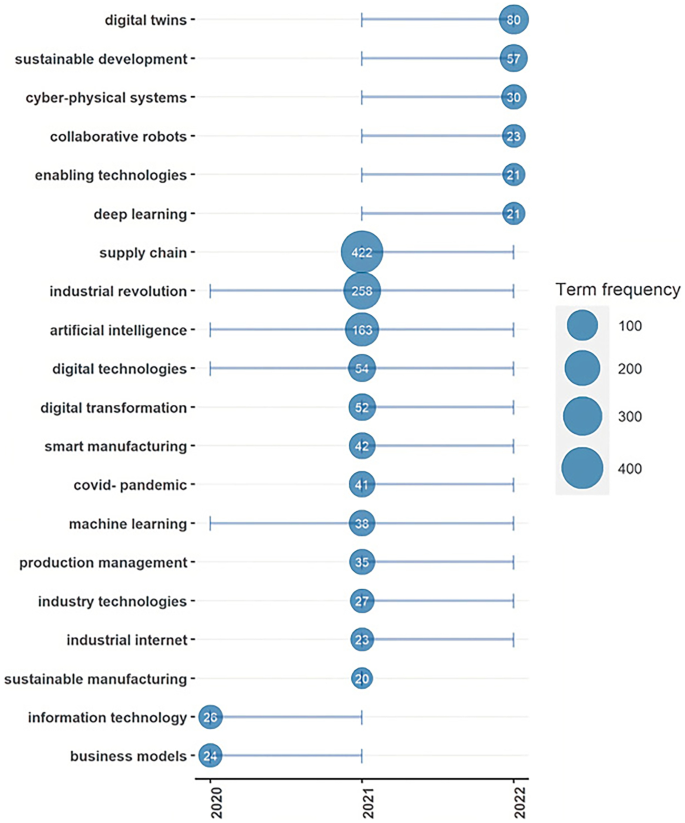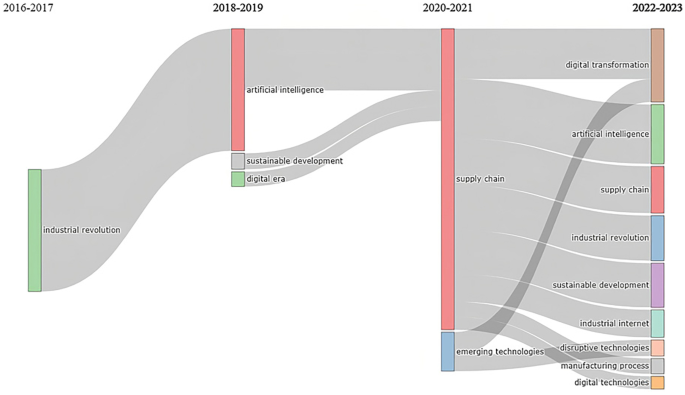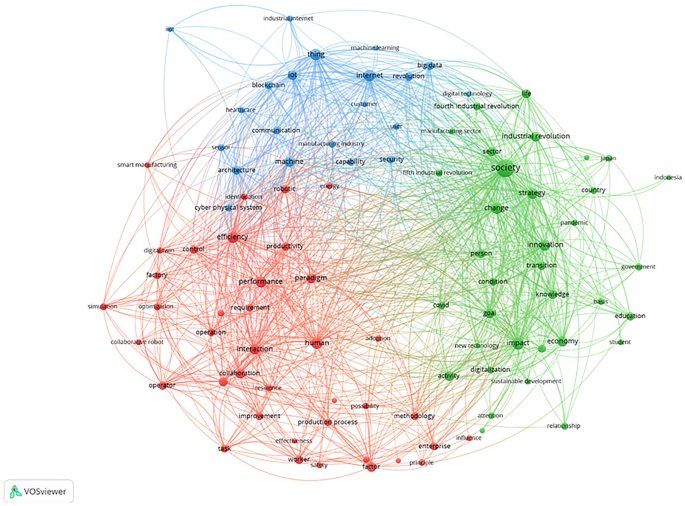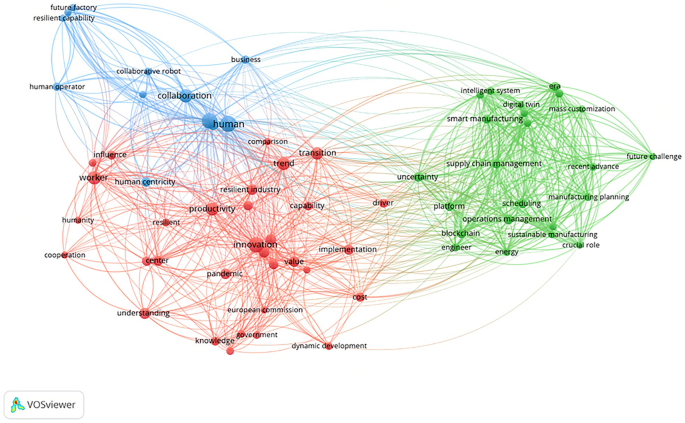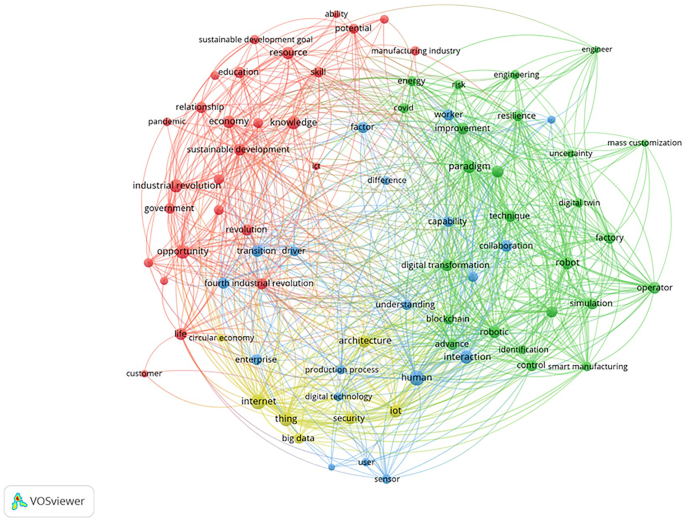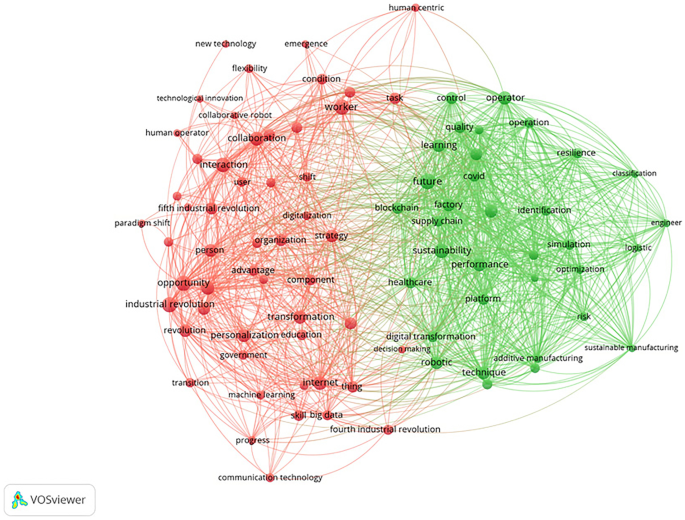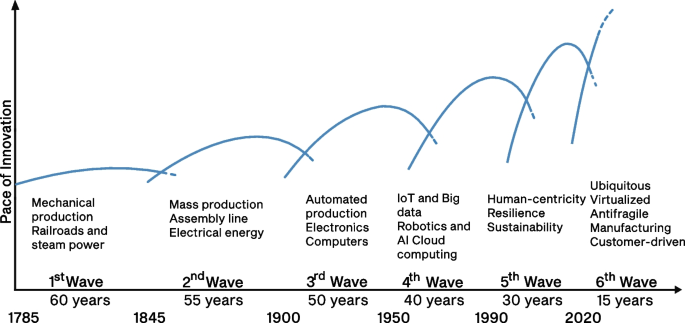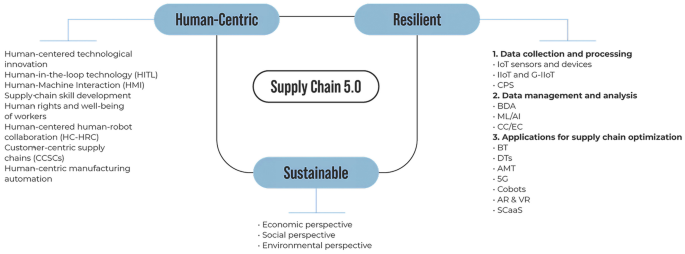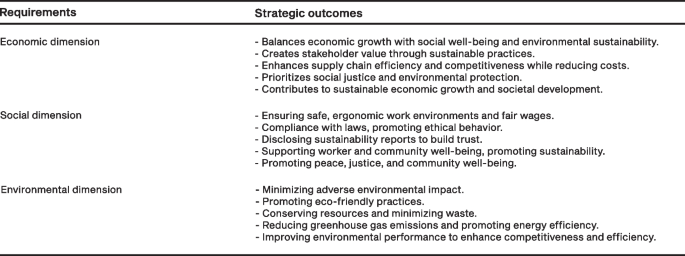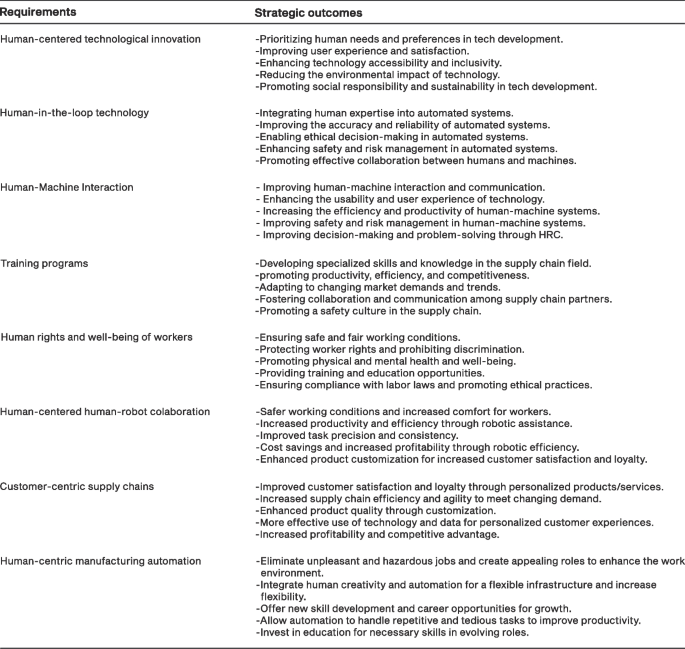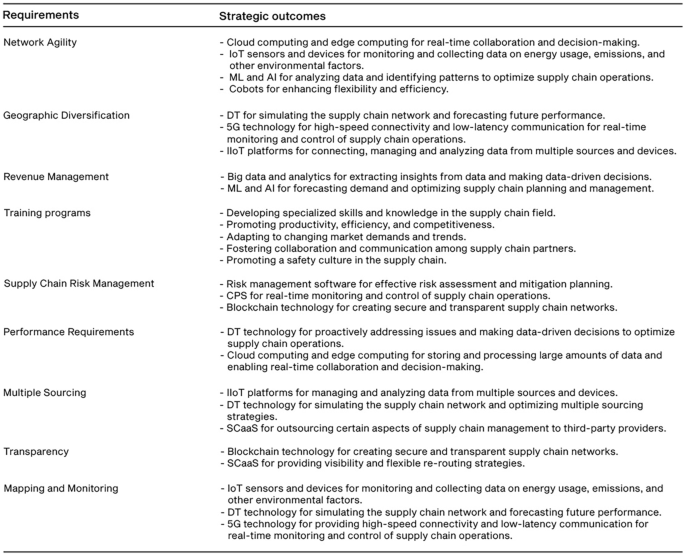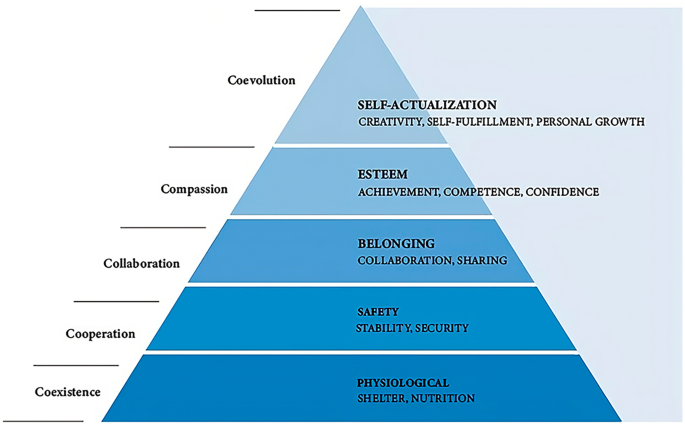Abstract
The purpose was to investigate the impact of the Industry 5.0 paradigm on the supply chain research field. Our study contributes to the conceptualization of supply chain 5.0, a term that has been receiving increased attention as supply chains adapt to the fifth industrial revolution. We conducted a systematic literature network analysis (SLNA) to examine the research landscape of Industry 5.0 supply chains. We used VOSViewer software and Bibliometrix R-package for multiple bibliometric analyses using 682 documents published between 2016 and 2022. We present a comprehensive framework of supply chain 5.0, including its key concepts, technologies, and trends. Additionally, this research offers a future research agenda to inspire and support further development in this field. We utilized three academic databases for bibliometric analyses: Dimension, Scopus and Lens. Additional databases could provide a wider research landscape and better field representation. We demonstrate how Industry 5.0 enables supply chain evaluation and optimization to assist companies in navigating disruptions without compromising competitiveness and profitability and provide a unique contribution to the field of supply chain 5.0 by exploring promising research areas and guiding the transition to this new paradigm for practitioners and scholars.
Similar content being viewed by others
Avoid common mistakes on your manuscript.
1 Introduction
The COVID-19 outbreak has led to an unprecedented disruption of commerce in most industry sectors, which created challenges in health and safety, supply chains, workforce, cash flow, consumer behavior, sales, and marketing [1]. Supply chain disruptions (SCDs) worldwide shed light on the fragility and vulnerability of supply chains in different aspects, including finance, lead time, demand changes, and production performance [2]. Amid unprecedented stress on global supply chains, the severity of the business disruption challenged the previous understanding of what constitutes a sustainable-resilient supply chain, encouraging research on SCD management strategies related to supply chain performance. As Moosavi et al. [2] revealed, resilience and sustainability have become primary research topics in the supply chain context.
This paper builds upon insights from Akundi et al. [3] in the bibliometric research paper “State of Industry 5.0—Analysis and Identification of Current Research Trends.” The authors conducted a topic analysis to understand the major themes in the published literature on the fifth industrial revolution, also known as Industry 5.0. They verified that the terms artificial intelligence (AI), big data, supply chain (SC), digital transformation, machine learning (ML), and Internet of Things (IoT) are the most often used and among several Industry 5.0 drivers identified by researchers. The term with the third highest count was “Supply Chain,” which suggests that Industry 5.0 will influence supply chains to an unprecedented level [3]. Drawing on the work of Akundi et al. the aim of our research is to investigate the impact of Industry 5.0 on modeling future supply chains.
To accomplish this goal, we performed a systematic literature network analysis (SLNA), which combines a bibliographic analysis with a systematic literature review (SLR). Through this mixed approach, which incorporates both qualitative and quantitative methods, we verified that, although the topic of supply chains in the context of Industry 5.0 is being widely explored, the term supply chain 5.0 is rarely used. We investigate the connectivity between Industry 5.0, Society 5.0, and supply chains to explore Industry 5.0 supply chains, herein referred to as supply chain 5.0.
For the bibliometric analysis, following PRISMA framework, we used 682 peer-reviewed documents (published from 2016 to 2022) from Lens, Scopus, and Dimensions databases. We applied Bibliometrix and VOSviewer software tools to visualize bibliometric network mappings and analyze the research landscape of supply chain 5.0. For our systematic literature review (SLR), we primarily used the 41 most globally cited documents (Table 4) and proposed a novel conceptual framework for supply chains 5.0. Our framework articulates the constructs of Industry 5.0 (human centricity, resilience, and sustainability) as they apply to future supply chains.
As a guiding framework for our study, we answer the following research questions (RQs):
-
RQ1–what does the fifth industrial revolution mean in the context of supply chains?
-
RQ2–what are the major topics and associated literature of supply chain 5.0?
-
RQ3–what would a supply chain 5.0 conceptual framework look like?
-
RQ4–what is the future research agenda related to supply chain 5.0?
Our paper is divided into six sections. Section 1 introduces and contextualizes the theme, presenting our motivation and the research gap the paper aims to fill. Section 2 details our methodology, which includes a combination of qualitative analysis and a bibliometric study. Section 3 presents the first part of our bibliometric research, focusing on the literature landscape and knowledge structure of supply chain 5.0. We use the Bibliometrix R-package to analyze annual production, locally and globally cited sources, wordclouds, word frequency over time, trend topics, and thematic evolution. Section 4 is the second part of our bibliometric research. Using the VOSviewer tool, we constructed keywords co-occurrence networks (KCNs) for supply chain 5.0 and its three major pillars: resilience, sustainability, and human centricity. Section 5 completes our systematic literature review, providing a theoretical background, analyzing the journey from supply chain 4.0 to supply chain 5.0, and creating a conceptual framework of supply chain 5.0. Section 6 presents a conceptual framework of supply chain 5.0. Section 7 is the discussion about bringing Maslow’s Hierarchy to Life in the supply chain context, which highlights the importance of human centricity in achieving sustainable supply chains. Section 8 offers a future research agenda to support further development in the field. Finally, Sect. 9 is the conclusion, summarizing the theoretical and practical implications of our findings.
2 Methodologies—Systematic Literature Network Analysis (SLNA)
The present research employs systematic literature network analysis (SLNA), a literature review method that combines qualitative and quantitative methods to provide a comprehensive understanding of a particular topic.
Conventional literature reviews usually rely on subjective content analysis, omitting the dynamic evolution of the research topic over time. On the other hand, the SLNA relies on objective tools (e.g, Bibliometrix and VOSviewer) and algorithms (e.g, citation network and keywords’ network) in assessing the bibliometric data generated from academic databases (e.g, Scopus, Lens, and Dimensions). Thus, SLNA provides the reader with a dynamic depiction of the research topic over a certain period, uncovering how academics have addressed a topic from its initial appearance [4, 5]. This allows for a more in-depth understanding of the field, identifying trending topics as well as areas of research that are under-explored. SLNA is a powerful research methodology that can help to improve the quality and rigor of research in a particular field.
Through this mixed approach, we examine the research landscape of supply chain 5.0 through a bibliometric analysis of 682 documents published from 2016 to 2022. Using SLNA, were able to develop an SLR on the supply chain 5.0 research landscape, including a dynamic depiction of the research topic’s progress over time, as well as identifying the key issues and main paths that have shaped its growth.
For the bibliometric research, we employed VOSviewer software and Bibliometrix R-package to construct and visualize networks using publications taken from three databases: Dimensions, Scopus, and Lens. For the systematic literature review, we applied PRISMA (Preferred Reporting Items for Systematic Review and Meta-Analyses), an evidence-based minimum set of items aimed at ensuring a transparent, accurate, replicable, and scientifically adequate systematic review [6].
Figure 1 illustrates the two stages of our systematic literature network analysis (SLNA), which ultimately culminate in the development of the conceptual framework (presented in Sect. 6) and the future research agenda for supply chain 5.0 (presented in Sect. 8).
2.1 First Phase of SLNA Methodology: Bibliometric Research
Our bibliometric research methodology follows three phases:
-
Phase 1 (Table 1)—assessment criteria
-
Phase 2 (Table 2)—search strategy methodology
-
Phase 3 (Table 3)—data gathering and preprocessing
The first phase is the assessment, presenting the criteria for inclusion. The second phase contains the search strategy methodology, in which we constructed four separate queries to search through the titles and abstracts in our scholarly databases. Search 1 aimed to find papers that refer to supply chain 5.0 directly or through joined concepts that together also refer to supply chain 5.0. The other three searches further subdivided the results based on the inclusion of the three specific pillars of Industry 5.0 (resilience, sustainability, and human centricity). The third phase is the data gathering and preprocessing, in which we executed our search strategy methodology from phase 2 to extract articles from three scholarly databases on November 3, 2021. A total of 1103 papers were identified. Table 3 shows the number of articles retrieved from each database in each separate search. Using Bibliometrix, we identified and removed 421 duplicate papers, leaving 682 unique documents for the bibliometric analysis.
2.2 Second Phase of SLNA Methodology: SLR
For our systematic literature review (SLR), we used the PRISMA methodology (Fig. 2). PRISMA (Preferred Reporting Items for Systematic Review and Meta-Analysis) consists of four major phases to critically investigate the subject matter: 1) identification, 2) screening, 3) eligibility, and 4) inclusion.
In the first stage, known as “identification,” we conducted a thorough search of three databases: Dimensions, Lens, and Scopus. From these databases, we collected a total of 1076 documents. As shown in our PRISMA diagram, the breakdown of documents collected from each individual database is as follows: Dimensions—351 documents, Lens—478 documents, and Scopus—247 documents. By utilizing multiple databases, we ensured a comprehensive search and increased the likelihood of finding all relevant studies.
The second stage of the PRISMA methodology is known as “screening.” During this stage, we reviewed the documents collected in the previous stage to determine which studies were relevant to our analysis. This process involved evaluating each study based on predefined inclusion and exclusion criteria. The goal was to identify studies that were both relevant for the final analysis and of high quality, ensuring the rigor and credibility of the systematic review. By systematically reviewing and selecting relevant articles, the screening process helps to minimize bias and increase the overall validity of the study’s findings.
In our screening phase, our full database of 682 documents was found to be eligible for inclusion. The reason for the high number of acceptable documents is that, during the search phase, we utilized appropriate Boolean logic in the queries to narrow the result field. The use of proper Boolean logic for database searching is crucial for a successful search, as it allows for more accurate and efficient retrieval of relevant research. The documents were also filtered by year, ensuring relevance to the study.
The third phase of the PRISMA methodology is called “eligibility criteria.” During this phase, we analyzed the documents that passed the previous “screening” stage to determine which studies were eligible for inclusion in the final analysis. In this phase, we identified no document as impertinent or unavailable, which means all articles passed this phase and were considered relevant to the systematic review.
In the fourth stage, known as the “inclusion” stage, we ended up with a total of 41 papers. To reach this result, we utilized a document co-citation analysis technique known as global citation analysis (GCA) to generate a ranked list of documents based on the number of citations received by each document globally. From this list, we first selected all papers that had received at least one citation, resulting in a total of 225 documents. We further narrowed this list by only including papers that had received at least 15 citations, resulting in a total of 41 documents for our SLR.
It is imperative to clarify that we chose a threshold of 15 citations to narrow down the list of highly cited documents while still encompassing a significant body of relevant literature. Initially, we experimented with a lower threshold of 10 citations, but this led to a substantially larger list of papers, making it challenging to maintain coherence and focus within the review. Opting for a threshold of 15 citations struck a reasonable balance and ensured a robust selection of influential works.
Furthermore, it is important to highlight that the final selection of 41 documents did not solely form the basis of our research findings. To augment the literature review, we conducted additional qualitative research, resulting in the inclusion of approximately 120 peer-reviewed documents. This involved a comprehensive approach, leveraging our complete database of 682 documents and conducting targeted searches on Google Scholar using search queries similar to those presented in Table 2. This meticulous approach enabled us to capture a broader range of perspectives and incorporate a diverse set of scholarly contributions.
By combining quantitative and qualitative approaches, we utilized the insights from the 41 most cited articles while incorporating a broader range of relevant studies. This integrated approach significantly enhanced the robustness and richness of our findings, contributing to a more thorough analysis of the subject matter.
3 Bibliometric Research Part 1: Overview of the Literature Landscape and Knowledge Structure of Supply Chain 5.0
In Sect. 3, we present a total of seven bibliometric graphs and maps generated from the full database of 682 documents using the Bibliometrix R-package.
3.1 Annual Evolution of Scientific Production and Main Information About Data
Figure 3 presents the annual evolution of scientific production in the field of supply chain 5.0. The graph is based on a sample of 678 documents from our full database, which contains 682 documents. The sample was selected by applying a time span of 2016–2022, so the graph does not include four documents published in 2023. This is to ensure that the output of 2023 is not misrepresented.
As shown in Fig. 3, the year 2016 marks the beginning of publications in the field of supply chain 5.0. Since then, there has been a steady increase in the number of publications in the field, but this growth became particularly intense following the COVID-19 outbreak in 2020. The sudden and widespread disruption caused by the pandemic highlighted the need for increased visibility, resilience, and digitization within supply chain management. This led to an increase in the number of publications, as more and more researchers and professionals focused on making supply chains more resilient, collaborative, and networked [7].
Our bibliometric analysis yielded some valuable insights. The average age of documents in our study was 1.19 years, with an average of 4.049 citations per document. Additionally, we observed an annual growth rate of scientific production of 87.77% from 2016 to 2022, indicating a growing interest in the theme and suggesting that this trend is likely to continue in the near future. As an emerging field, we expect that the scientific contributions to supply chain 5.0 will continue to grow in the coming years.
3.2 Most Local Cited Sources (from Reference List)
To find the most local cited sources (from Reference List), Bibliometrix counts the citations that a document has received within other documents included in our collection. Our database collection of 682 documents contained 268 sources (e.g, journals, books, conference proceedings, and others). In order to identify the leading outlets in advancing supply chain 5.0 research, we employed a parameter of sources with at least 100 citations. This resulted in a ranking of the 14 most locally cited sources, as shown in Fig. 4.
3.3 Most Globally Cited Documents
A bibliometric analysis of the most globally cited documents, also known as global citation analysis (GCA), is a method used to evaluate the impact of scientific publications by analyzing the number of citations they have received from documents indexed in any bibliographic database (e.g, WoS and Scopus). It is worth noting that the GCA considers the total number of citations a document has received, even if those citing papers were not included in our database collection. This means that the GCA analysis is not limited to papers included in a specific database, but it takes into consideration all the citations that a paper has received in the world [8]. This makes GCA a powerful tool to evaluate the impact of scientific publications and identify the most influential papers in a field of study.
Figure 5 presents the ranked list of the 41 most globally cited documents, which we then use for our systematic literature review (SLR). Table 4 provides additional details for each document in the ranked list, including the full title, the total number of citations per year (TC per year), and the normalized citation impact scores (normalized TC). These metrics allow for a more comprehensive understanding of the relevance of each document in the field.
3.4 Wordcloud
The wordcloud presented in Fig. 6 provides a visual representation of the most used bigrams associated with the ongoing digital transformation of supply chains within Industry 4.0 and the transition to Industry 5.0 supply chains. We selected 15 bigrams based on their frequency within the abstracts of our full database of 682 documents (2016 to 2023). The size of each bigram varies according to the number of times it appears in the text. Although the placement of words is somewhat random, the predominant words appear largest and in the middle of the cloud, while the less prominent bigrams are smaller, but still indicate potential directions for future research.
The wordcloud highlights the shift toward the Fifth Industrial Revolution builds on the foundation of Industry 4.0 and adds a focus on sustainable development goals (SDG) and human-centric manufacturing [9]. It emphasizes the importance of the terms “artificial intelligence (AI),” “sustainability,” “digital technologies,” “digital transformation,” “digital twins” (DT), “smart manufacturing,” “information technology (IT),” “machine learning (ML),” “production management,” and “cyber-physical system” (CPS) in this transition. The wordcloud also includes the “covid pandemic” crisis, which has significantly accelerated the adoption of digital technologies in supply chains [10,11,12].
3.5 Word Frequency
Figure 7 presents word frequency over time, showcasing the five words most frequently used in supply chain 5.0 research from 2016 to 2022. We selected five bigrams based on their cumulative occurrences within the abstracts of our database of 679 documents (2016 to 2022). We excluded the year 2023 as it only had three papers, which is not a representative sample.
As depicted in the graph, the majority of these keywords experienced a significant increase in research interest in 2020, coinciding with the outbreak of COVID-19 as a global pandemic. As the effects of COVID-19 continue to affect the global supply chain, there has been a significant amount of research conducted into how Industry 5.0 resilience can optimize supply chains to help companies navigate disruptions without compromising competitiveness and profitability.
Figure 7 shows an exponential increase in the occurrences of the terms “supply chain,” “industrial revolution,” “artificial intelligence (AI),” “digital twins (DT),” and “sustainable development” in 2020, after COVID-19. This trend suggests a growing interest in how emerging technologies such as AI and digital twins can revolutionize manufacturing supply chains and contribute to sustainable development within the framework of Industry 5.0.
3.6 Trending Topics
The identification of trending topics is a valuable tool for researchers as it allows them to focus their attention on areas of study that are gaining prominence. By knowing these trends, researchers can stay up-to-date with the latest developments in their field and prioritize their research efforts to align with the most current and relevant topics.
To generate the trending topics graph, we configured the following parameters: bigrams based on abstracts, word minimum frequency of 20, and a maximum of 15 words per year. The timespan of our trending topics graph focuses only on 2020–2022 because, as shown in the word frequency graph (Fig. 7), interest in the topic of I50-SCs has increased notably since the COVID-19 outbreak. By limiting our analysis to this time period, we are able to capture and highlight trending topics that have experienced a significant increase in interest.
Figure 8 presents a hierarchical arrangement of the emerging trends in I50-SCs as discussed in academic publications. The graph showcases the relative prominence of different topics in each year. The length of the lines in the graph represents the strength or intensity of a particular topic’s trend over time.
Longer lines indicate stronger, more significant trends for specific topics. They suggest that these topics have been receiving more attention and generating a higher volume of publications or citations during that period. On the other hand, shorter lines represent weaker trends or lower levels of activity for a particular topic, meaning that it has received relatively less attention in terms of publications or citations.
Comparing the lengths of lines over time allows us to identify shifts in research interest. If a line becomes longer or shorter in subsequent periods, it suggests a change in the topic’s significance or attention within the research community.
Figure 8 reveals that digital twins (DT) was the most discussed topic in 2022, followed in order by sustainable development, cyber-physical systems (CPS), collaborative robots (cobots), enabling technologies, deep learning, digital transformation, smart manufacturing, the COVID-19 pandemic, industry technologies (Industry 4.0 and 5.0), industrial internet, and sustainable manufacturing. Additionally, Fig. 11 shows that the industrial revolution, digital technologies, machine learning (ML), and artificial intelligence (AI) have remained trending topics since 2020. It is important to note that Bibliometrix R-package does not include numbers when it selects bigrams. For this reason, the graph in Fig. 8 does not separate the expressions “industry 4.0 technology” and “industry 5.0 technology,” but instead groups them under the single term “industry technologies.”
3.7 Thematic Evolution
The thematic evolution graph depicted in Fig. 9 provides a visual representation of the knowledge structure and the progressive evolution of themes within the context of Industry 5.0 supply chains. By analyzing this graph, it is possible to identify the most prevalent concepts and their connections throughout the years.
In particular, the graph utilizes different visual elements, including nodes and edges, to represent the evolving themes and their relationships. The nodes represent distinct themes or concepts, while the edges, indicated by gray connectors, signify the connections between these themes.
The gray connectors in the thematic evolution graph represent co-citation relationships, indicating that the connected themes share common references or are frequently cited together in scholarly literature. These co-citation relationships suggest thematic similarity or relatedness between the interconnected concepts.
By analyzing the gray connectors, it is possible to gain deeper insights into the interrelationships and co-occurrence of themes throughout the years. These connections provide valuable information about the flow of knowledge and the evolution of ideas within the domain of Industry 5.0 supply chains.
To generate this graph, we used the following parameters: bigrams were generated based on abstracts, the Louvain clustering algorithm was employed, and a timespan of 2016 to 2023 was used, utilizing our full database of 682 documents.
The first column of Fig. 9 (2016–2017) represents the earliest publications on the fifth industrial revolution. The term Industry 5.0 was introduced on December 1, 2015, in an article published by Michael Rada on the social network LinkedIn.
The second column (2018–2019) shows that the terms “artificial intelligence,” “sustainable development,” and “digital era” were key drivers of I50-SCs research at that time.
The third column (2020–2021) highlights the terms “supply chain” and “emerging technologies,” which indicates a growing focus on I50-SCs development and implementation of innovative technologies in response to the challenges posed by the COVID-19 outbreak. The pandemic has fundamentally reshaped the way in which manufacturing and supply chain management are approached, greatly accelerating the adoption of digital technologies [10, 13]. The thematic evolution graph reflects the increasing emphasis on these technologies.
The fourth column (2022–23) shows the emerging technologies highlighted in the third column, emphasizing a continued focus on digital supply chain transformation and the shift toward value-driven supply chains. A value-driven supply chain prioritizes sustainable development, which includes not only economic performance but also social and environmental sustainability. This reflects a growing emphasis on building smarter and more resilient supply chains, in alignment with the visions of Industry 5.0 and Society 5.0 [14].
4 Bibliometric Research Part II: Keywords Co-occurrence Networks (KCNs)
In order to understand the impacts of Industry 5.0 on supply chains, we conducted a bibliometric KCN analysis using VOSviewer software to identify clusters associated with supply chain 5.0 (Search 1) and its three major pillars: resilience (Search 2), sustainability (Search 3), and human centricity (Search 4). By analyzing the literature in these areas, we were better able to understand the key themes and trends shaping the future of supply chain management and operations, as well as identify opportunities for further research and development.
To construct the four bibliometric maps, we applied similar settings in the VOSviewer: a) term co-occurrence maps based on text data, extracting terms from the title and abstract fields of our full database of 682 documents; b) binary counting; and c) select the most relevant keywords in the network, using the default choice of 60%.
To control the number of terms in each map and to make them more readable, we set a minimum number of occurrences of a term for each cluster; the following values were chosen to limit the number of terms to 200. For Search 1, the minimum number of occurrences of a term was 32 (194 met the threshold, and 116 terms were selected). For Search 2, the minimum number of occurrences of a term was 6 (174 met the threshold, and 104 terms were selected). For Search 3, the minimum number of occurrences of a term was 18 (195 meet the threshold, and 117 terms were selected). For Search 4, the minimum number of occurrences of a term was 9 (185 meet the threshold, and 111 terms were selected). After applying the default choice to select the 60% most relevant terms and elimination repetition, 145 total terms were selected across all four clusters. This approach allowed us to identify key terms and connections within the literature, providing insights into the current state of research and potential areas for future study.
In order to ensure the relevance and accuracy of our analysis, keywords not relevant to our study were excluded manually. This included words typically found in abstracts, such as ‘scenario,’ ‘evaluation,’ ‘overview,’ ‘article,’ ‘case study,’ ‘literature,’ ‘literature review,’ and expressions to describe context, such as ‘set,’ ‘place’, ‘factor,’ ‘prospect,’ ‘identification,’ ‘basis,’ and ‘issue.’ These words were removed to focus on the concepts that more closely relate to this study.
Next, we present an analysis of the four bibliometric maps. They allow us to visualize the connections between different terms within the literature, providing a clear and comprehensive understanding of the key themes and trends shaping the future of supply chains.
-
Search 1: supply chain 5.0
Figure 10 illustrates the cluster analysis results in the context of supply chain 5.0. As shown in the figure, three major clusters can be identified, which are colored green, red, and blue.
The green cluster shows the digital transformation of manufacturing, which offers great opportunities for sustainable manufacturing in the transition to Industry 5.0 and Society 5.0. The main terms the green cluster uses are as follows: fourth industrial revolution, fifth industrial revolution, society, transition, manufacturing sector, flexible, technological innovation, digitalization, government, sustainable development, goal, economy, education, skill, knowledge, and covid.
The red cluster focuses on human–machine interaction (HMI), a key technology for the implementation of smart manufacturing to achieve efficient human–robot collaboration. The main keywords shown are: smart manufacturing, manufacturing industry, collaboration, collaborative robot, operator, digital twin, efficiency, human, robot, interaction, optimization, performance, productivity, resilience, and safety.
The blue cluster illustrates the integration of smart manufacturing technologies under Industry 5.0. The main keywords associated with this cluster are big data, architecture, blockchain, communication, customer, cyber-physical system, digital technology, IIot, IoT, machine learning, sensor, and security.
-
Search 2: supply chain 5.0 and resilience
Figure 11 illustrates the cluster analysis results in the context of resilience within supply chain 5.0. There are three major clusters, which once again are colored green, red, and blue. Each cluster represents a distinct group of factors that contribute to resilience in supply chain 5.0.
The green cluster contains words related to Industry 5.0 core values (human centricity, sustainability, and resilience) in smart manufacturing. The most relevant keywords are: smart manufacturing, sustainable development, sustainable manufacturing, resilient, human-centric, European Commission, production process, innovation, and pandemic.
The red cluster addresses the challenges and opportunities of smart manufacturing resilience strategies through the integration of advanced technologies in the wake of the COVID-19 pandemic. The main keywords in this cluster are blockchain, digital twin, scheduling, future challenge, platform, quality, production system, intelligent system, mass customization, smart manufacturing, and sustainable development supply chain management.
The blue cluster addresses one of the key emerging themes for Industry 5.0, human–robot collaboration, and the core idea behind Industry 5.0, which is to place the human factor at the center of the production process. This cluster highlights terms such as: human centricity, human operator, collaborative robot, business collaboration, future factory, and resilient capability.
-
Search 3: 5IR supply chains and sustainability
Figure 12 illustrates the cluster analysis results for supply chain sustainability within the context of Industry 5.0. We can identify four major clusters, which are colored red, green, blue, and yellow. Each cluster represents a distinct group of factors that contribute to supply chain sustainability in Industry 5.0.
The red cluster contains keywords related to sustainable development challenges, especially after the supply chain disruptions caused by the COVID-19 pandemic. The most relevant terms in this cluster are: sustainable development, sustainable development goal, technological innovation, digitalization, pandemic, manufacturing industry, production process, education, economy, customer, company, organization, opportunity, and business model.
The green cluster illustrates the ongoing digital transformation towards smart manufacturing within post-COVID Industry 5.0. The most relevant terms in this cluster are blockchain, covid, digital twin, simulation, mass customization, optimization, paradigm, resilience, robot, and smart manufacturing.
The blue cluster focuses on machine learning methodologies for human–robot interaction in the manufacturing sector. The most relevant terms in this cluster are: collaboration, cyber-physical systems, digital technology, human factor, interaction, machine learning, and production process.
The yellow cluster addresses recent research on circular economy (CE) and big data/IoT. The most important terms in this cluster are: architecture, big data, circular economy, Internet of things (IoT), and security.
-
Search 4: 5IR supply chains and human centricity
Figure 13 illustrates the clustering results for human-centricity within the context of supply chain 5.0. We can identify two major clusters, which are colored green and red.
The red cluster explores the role of digital transformation during the transition from Industry 4.0 to 5.0, highlighting the shift from a technology-focused approach to a human-centric approach. This cluster delves into the concept of human-centric manufacturing, which emphasizes empathic collaboration between humans and machines. Worker well-being is placed at the center of the manufacturing process, with continuous learning of skills and knowledge. The most relevant terms in this cluster are big data, collaboration, collaborative robot, communication technology, consumer, customization, cyber-physical system, decision making, digital technology, education, fifth industrial revolution, fourth industrial revolution, flexibility, government, human-centric, human operator, interaction, machine learning, personalization, and sensor.
The green cluster focuses on the future of manufacturing based on lessons learned from the pandemic. It addresses key strategies and technologies necessary for achieving human-centric smart manufacturing. The most relevant terms in this cluster are additive manufacturing, blockchain, covid, digital transformation, digital twin, energy, factory, future, learning, mass customization, operator, performance, platform, quality, resilience, simulation, smart manufacturing, sustainability, and sustainable manufacturing.
5 Second Phase of SLNA Methodology—Systematic Literature Review of Supply Chain 5.0
Section 5 builds on the knowledge gathered from the bibliometric research conducted in the first phase, providing a detailed examination of the evolution of supply chains and the novel concept of supply chain 5.0. The section is divided into four subsections. In Sect. 5.1, we trace the historical development of industrial revolutions from 1.0 to 6.0 through a literature review. Then, Sect. 5.2 examines the transition from supply chain 4.0 to supply chain 5.0, highlighting the key changes and advancements that have led to this new paradigm. In Sect. 5.3, we delve into the concept of supply chain 5.0 itself, analyzing its three major pillars: resilience, sustainability, and human centricity. Our analysis is based on the four clusters generated through keywords co-occurrence networks (KCNs). Finally, in Sect. 6, we present a comprehensive conceptual framework which encapsulates the key pillars that characterize supply chain 5.0.
5.1 Industry 1.0 to Industry 6.0: A Brief Overview
Since the Industrial Revolution, which began in the eighteenth century, six waves of technological innovation can be identified (See Fig. 14). The first wave, known as the Age of Steam, marked the transition from hand-made methods to mechanized manufacturing using water and steam. The second wave, the Age of Electricity, brought significant industrialization and innovation into steel production, petroleum, and electricity. The third wave, the Age of Automation, launched the Information Age and marked a shift to an economy based primarily on information and technology systems. The fourth wave, the Digital Age, has been progressing since the mid-1900s and represents a paradigm shift in organizing and managing industrial business. It is characterized by the incorporation of smart technology in traditional manufacturing and industrial practices, leading to a digital transformation of production systems, business models, environments, operators, machines, products, and services [15],
The fourth wave, known as Industry 4.0 (I40), initially focused on manufacturing, supply chain management, and production. The vision of I40 is to integrate advanced technologies such as the Internet of Things (IoT), artificial intelligence (AI), and cyber-physical systems (CPS) to make the manufacturing industry “smart” and increase productivity through mass production [18]. However, there are still significant challenges to overcome, such as a shortage of skilled labor, limited knowledge on the implementation of I40 technologies, and potential technology-related job displacement [19].
Although Industry 4.0 has been successful in lowering manufacturing costs and optimizing production processes, it has prioritized these goals at the expense of human needs. The highly automated production environment in I40 has raised concerns that humans may no longer play a valuable role in the manufacturing process. This concern led the European Economic and Social Committee to hold a conference in November 2018 to address the social challenges and potential negative impacts of Industry 4.0, such as job displacement and the need for new skills, and to develop a more holistic vision for the future of manufacturing that takes into account both technological and social considerations [20].
These ideals distinguish the Fifth Industrial Revolution (I50), also known as the Age of Augmentation, from the fourth. I50 builds upon the technological advancements of Industry 4.0. However, while I40 is focused on the concept of “Smart Manufacturing for the Future” [21], I50 envisions sustainable smart manufacturing solutions that not only enhance productivity and efficiency but also consider the environmental and social impacts of manufacturing processes [18]. The fifth industrial revolution is more concerned with symbiotic and smooth relationships between humans and machines, with special attention to ethical considerations [22].
In January 2021, the European Commission [23] released its Industry 5.0 agenda for resilient, sustainable, and human-centric European Industry. The commission’s report shows that geopolitical changes and natural crises such as the COVID-19 pandemic exposed the fragility of industries, highlighting the need for rapid adaptability and resiliency. According to this agenda, I5.0 promotes a sustainable lifestyle through the 6Rs of sustainability (recognize, reconsider, realize, reduce, reuse and recycle), which recommends the implementation of circular processes to reduce the impact of technology on people and the environment. As a human-centric solution, I5.0 must ensure that technological advancements address the challenges of sustainable development and positively impact society, protecting human rights and driving employee well-being [14, 18, 24, 25].
Finally, the Sixth Industrial Revolution, or Industry 6.0 (I60), is an ideological and futuristic concept defined as ubiquitous, customer-driven, virtualized, antifragile manufacturing. It will encompass a customer-focused ethos and hyper-connected industries with dynamic supply chains where data flows across domains [26,27,28].
Figure 14 presents a historical overview of innovation cycles, ranging from Industry 1.0 to Industry 6.0. The data suggests a notable trend of shorter periods between wave cycles of innovation. This pattern leads us to contemplate the possibility of the sixth industrial revolution commencing within the next two decades. In line with this, Chourasia et al. [26] assert that the realization of Industry 5.0’s integration of sustainability and anti-fragile goals is estimated to require approximately 10 to 15 years for full implementation. By considering these insights, we gain valuable perspectives on the potential timeline and transformative nature of future industrial advancements.
5.2 From Supply Chain 4.0 to Supply Chain 5.0
The transition from supply chain 4.0 to supply chain 5.0 is a major milestone in the world of supply chain management. Supply chain 4.0 brought significant advancements in terms of technology and efficiency, while supply chain 5.0 incorporates new technologies and practices that allow for human-centric, sustainable, and resilient supply chains.
The term supply chain 4.0 refers to the integration of Industry 4.0 technologies into the entire supply chain, from design planning to production, distribution, consumption, and reverse logistics. This integration optimizes and automates the supply chain, making it more connected and responsive to changing market conditions and consumer demands. Unlike traditional supply chains, which were characterized by linear links between suppliers and customers, in supply chain 4.0, information flow in all directions, allowing for more flexibility and adaptability [29].
Supply chain 4.0 represents a major restructuring of traditional supply chains through the integration of key Industry 4.0 technologies, including artificial intelligence (AI), cloud manufacturing, blockchain, cyber-physical systems (CPS) [30], big data analytics, IoT and IIoT, sensor technology, additive manufacturing, and other industrial automation technologies [13, 31,32,33] .Additionally, new connectivity technologies such as 5G and Wi-Fi 6, Digital Twins, Virtual Reality (VR), and augmented reality (AR) [34], Maddikunta et al. [18] also play an important role, allowing for more accurate and efficient tracking and control of inventory, production processes, and logistics. These technologies work together to create a more connected and automated supply chain, allowing organizations to respond quickly to changes in market conditions and consumer demands.
The integration of Industry 4.0 technologies into the supply chain has revolutionized the way organizations approach their operations. The implementation of a data-driven, decentralized system with resources that are geographically distributed and interconnected has allowed for improved adaptability and the capability of fully flexible production at the highest speed possible [35, 36]. For example, by harnessing the power of Industry 4.0 technologies, the agricultural industry has been able to make informed decisions, improve efficiency and productivity, and ultimately achieve better outcomes. The concept of Agriculture 4.0, also known as smart agriculture, represents this new way of organizing the agricultural sector into an intelligent, data-driven decision-making system [37].
The service-oriented architecture (SOA) is a fundamental building block of smart manufacturing in supply chain 4.0. It offers services that support virtual reality (VR) and augmented reality (AR), providing an interface to interact with the digital world in the smart factory. The use of VR and AR in smart manufacturing has revolutionized product development and production processes, enabling more efficient and effective design and production. This ability to dynamically adapt and evolve is critical to the success of a smart manufacturing environment, allowing for rapid response to customer needs and market changes [38].
As highlighted in various studies, supply chain 4.0 leverages smart manufacturing to optimize production processes [18, 39], improve operational efficiency [39, 40], create greater flexibility and real-time information sharing [39, 41], facilitate operational transparency [18, 42], raise quality and reduce cost [31], enhance customer experience through customization of products and services [43], and improve communication, coordination, and collaboration [44]. However, despite these advancements, supply chain 4.0 still faced challenges in terms of sustainability and resilience, particularly in the face of disruptions such as natural disasters or pandemics.
The COVID-19 pandemic has exposed the vulnerabilities and limitations of supply chains, despite the potential benefits of Industry 4.0 technologies in optimizing supply chain operations and improving agility. The pandemic has underscored the need for more resilient and robust systems that can withstand unexpected disruptions on a global scale. The response to the pandemic may promote the development of new innovative technologies and contribute to the evolution of the fifth industrial revolution, which aims to create more sustainable, flexible, and adaptable supply chains [45].
This is where Industry 5.0 comes in. It aims to go beyond Industry 4.0 by creating a combination of organizational principles and technologies to design and manage operations and supply chains as resilient, sustainable, and human-centric systems [46].
Supply chain 5.0 builds upon the achievements of supply chain 4.0 while prioritizing social and ethical factors such as workplace safety, health, and environmental sustainability. This human-centric supply chain management model has the potential to deliver substantial benefits to both customers and businesses, creating more resilient and efficient supply chains. Supply chain 5.0 emphasizes the shift from mass production to mass customization, with skilled workers collaborating with robots to offer personalized products and services, which enhances customer experience while improving productivity, efficiency, and waste reduction. This new approach to supply chain management is expected to play a critical role in creating more sustainable and socially responsible businesses in the future [43, 40, 47, 48].
5.3 Supply Chain 5.0 Constructs
In this section, we will examine three key constructs of supply chain 5.0 in order to gain a deeper understanding of how these factors are shaping the future of supply chain management. The literature review will provide valuable insights into the challenges and opportunities presented by supply chain 5.0, and how organizations can best prepare for, and adapt to, these changes.
5.3.1 Human-Centric Supply Chains (HCSCs)
The principle of human centricity emphasizes that machines and automation should be subservient to humans, not the other way around [49]. The human-centric supply chain (HCSC) takes this approach to supply chain management by placing people at the center of the process. Through the use of technology, the HCSC aims to create a sustainable society that prioritizes corporate social and environmental responsibility in supply chain development [50, 51].
The HCSC approach is becoming increasingly important as supply chains evolve towards the Society 5.0 paradigm. The concept of Society 5.0 is a Japanese initiative that envisions a “super-smart society” that focuses on human-centered and sustainable solutions to meet customer needs and social problems through technological innovation [52]. The Japanese government defines 17 actions to be implemented within Society 5.0 to achieve the Sustainable Development Goals (SDGs) in the year 2030. The Sustainable Development Goals (SDGs), also known as the Global Goals, were adopted by the United Nations by all United Nations Member States in 2015 and provide a shared blueprint for peace and prosperity for people and the planet, now and into the future [53, 54]
Big data, IoT, and AI are the critical Industry 4.0 (I40) technologies for the transition to Society 5.0. Together, these technologies provide all the initiating and sharing information processes required to design Society 5.0 solutions [55] The integration of Industry 4.0 technologies in the development of Society 5.0 solutions requires the implementation of new business models, services, and products by managers [56, 57].
In the context of the evolution towards Industry 5.0, a human-centric approach to supply chain management becomes crucial as it prioritizes the well-being of workers, consumers, and individuals. This approach aligns technological progress with socio-environmental needs, promoting sustainability and social responsibility in the manufacturing industry [18]. By placing the human factor at the center of the manufacturing process, job satisfaction, working conditions, and productivity can all be improved [58].
The concept of “Operator 4.0” represents a human perspective that addresses the social-sustainability and human centricity requirements of Industry 5.0. The Operator 4.0 paradigm redefines traditional manufacturing work by making it more safe, enjoyable, and with greater autonomy and opportunities for self-development. This is accomplished through the integration of cognitive technologies with Industry 4.0 technologies. As a result, the traditional manufacturing worker is transformed into a smart and skilled operator [59].
As a result, Industry 5.0 is paving the way toward a more efficient and sustainable future for manufacturing by restructuring the supply chain to prioritize the needs and well-being of workers and customers. This shift is driven by the psychological and cultural paradigm of mass personalization, promoting a human-centered approach that adds value to manufacturing as it personalizes products and services like never before [60, 61].
Next, we present the key elements of HCSCs:
-
i.
Human-centered technological innovation (HCTI)
Human-centered technological innovation is an approach to technology development that prioritizes people’s needs, while also considering the impact on the environment and society as a whole [18]. This approach is based on human-centered design principles that emphasize empathy, understanding, and collaboration with end-users to create technology that is user-friendly and meets user needs.
-
ii.
Human-in-the-loop technology (HITL)
HITL technology refers to the integration of human input into automated processes for improved decision-making and quality control. It allows for human oversight and final decisions on important aspects such as product quality, safety, and compliance with regulations. The HITL approach promotes effective collaboration between humans and machines, ensuring continued operations, even in the case of equipment failure, and enables ethical decision-making [62].
-
iii.
Human–machine interaction (HMI)
The field of HMI is a rapidly growing interdisciplinary area that aims to facilitate smooth and efficient collaboration between humans and robots. This field brings together various disciplines such as psychology, computer science, engineering, and human factors to create effective systems for human–robot collaboration (HRC). Despite the challenges, the future of HMI holds great promise for improving HRC, creating new jobs, and driving technological progress [24].
-
iv.
Supply chain skill development (SCSD)
Training programs for supply chain skill development have become a crucial aspect of business operations. With the rapid advancements in technology, companies must ensure their employees have the necessary skills to effectively operate new technologies and perform high-value tasks in production. This is essential for long-term success and competitiveness in the marketplace [15, 42, 63,64,65]. To provide appropriate training, virtual technologies such as AR/VR are increasingly being used, offering a safe and efficient solution for training a skilled workforce without disrupting ongoing processes or exposing workers to dangerous scenarios [24].
-
v.
Human rights and well-being (HRWB)
A human-centric supply chain (HCSC) places workers at the center of its operations and prioritizes their well-being and rights. By incorporating social and ethical practices into its operations, a human-centric supply chain creates a safe and inclusive work environment that respects the autonomy, dignity, and privacy of workers, with a focus on their physical and mental health [9, 66, 67]. By promoting fair labor practices, non-discrimination, and access to education and training, a human-centric supply chain also supports the personal and professional development of workers, contributing to their career growth and future prospects.
-
vi.
Human-centered human–robot collaboration (HC-HRC)
A Human-centered human–robot collaboration (HC-HRC) is a human-centric approach where robots are designed and deployed with a focus on human safety, comfort, and needs. Recent studies have highlighted the importance of collaborative robots (cobots) in reducing the risk of injuries and fatigue among workers, as well as increasing efficiency and creating more specialized and personalized products and experiences [14, 18, 68, 69], and [70].
-
vii.
Customer-centric supply chains (CCSCs)
Customer-centric supply chains (CCSCs) prioritize the preferences and requirements of customers throughout the entire process of sourcing, production, and delivery of goods and services. This approach requires production lines to be adaptive, intelligent, and flexible enough to meet updated requests, ensuring that the needs of each customer are met [24]. To enhance the customer experience, virtual reality (VR) and augmented reality (AR) technologies can be used in the purchasing phase, while sensors and AI can provide real-time support in the post-sale phase. Data privacy and ethical issues must also be considered when offering customized services [18, 64, 71].
The implementation of CCSCs involves a shift from mass production to personalized production, allowing for the creation of unique and customized products and services for each individual customer. This approach results in increased competitiveness and revenue for businesses, as well as better customer relationships and long-term success [72].
-
viii.
Human-centric manufacturing automation (HCMA)
Industry 5.0 is revolutionizing the manufacturing industry by incorporating autonomous machines, cobots, and other digital technologies. This approach aims to increase manufacturing system efficiency and reduce waste, ultimately leading to a reduction in the final cost of products [24, 43]. However, a human-centric approach to manufacturing automation, which integrates human creativity and automation, can further enhance the benefits of Industry 5.0. This approach not only eliminates unpleasant and hazardous jobs but also creates more fulfilling and appealing roles for workers, resulting in a positive work environment [9, 58]. As automation continues to transform the workforce, it is essential for companies and governments to invest in education programs to equip workers with the necessary skills to succeed in these evolving roles [73]. With the right approach and investment, Industry 5.0 can offer workers new opportunities for skill development and more fulfilling careers while driving the manufacturing industry forward.
5.3.2 Sustainable Supply Chains (SSCs)
Industry 5.0 represents a paradigm shift in the manufacturing industry, moving away from a system-centric approach and towards a human-centric approach with a focus on sustainability. The integration of advanced technologies into the manufacturing sector aims to augment the capabilities of human workers while minimizing environmental and social impacts. Supply chain 5.0 prioritizes sustainable manufacturing and the well-being of human operators, as well as productivity goals. This holistic approach to industrial development sets the stage for a more sustainable and equitable future [14].
Sustainable supply chain (SSC) refers to the integration of sustainable development principles into the management and operation of supply chain activities. It takes a triple-bottom-line approach, balancing economic, social, and environmental sustainability. SSC focuses on ensuring economic growth while also being socially responsible and environmentally conscious in the management and operation of supply chain activities.
On the same note, sustainable supply chain management (SSCM) involves the strategic and transparent management of supply chain activities with a focus on sustainability [74]. Implementing SSCM can lead to reduced operational costs, improved company image, and better monitoring of environmental actions [75, 76]. The entire life cycle of a product or service is considered, from raw material sourcing to end-of-life product disposal, to ensure that economic, social, and environmental impacts are taken into account.
In 2015, the United Nations Development Program (UNDP) proposed 17 Sustainable Development Goals (SDGs) to drive action in critical areas for humanity and the planet over the next 15 years. These goals promote sustainable practices and are adapted to each nation’s financial and social circumstances [12, 77,78,79]. The 17 SDGs provide a framework for businesses to operate more sustainably and responsibly, with supply chains playing a crucial role in contributing to these goals. It is worth noting that some SDGs may overlap between multiple categories and some SDGs may contribute to multiple sustainability categories.
The social goals include no poverty, zero hunger, good health and well-being, quality education, gender equality, clean water and sanitation, and affordable and clean energy. The environmental goals include responsible consumption and production, climate action, life below water, and life on land. The economic goals include decent work and economic growth, industry, innovation and infrastructure, reduced inequalities, sustainable cities and communities, and partnerships for the goals. Achieving these goals will require the collective efforts of governments, civil society, the private sector, and individuals worldwide.
Supply chains play a critical role in advancing the UNDP 17 SDGs. Supply chains can make a significant impact on these goals by integrating sustainable practices into their operations. By considering the entire life cycle of a product, from raw material sourcing to end-of-life product disposal, supply chains can play a key role in promoting sustainable development and creating a more sustainable future for all.
In the following sections, we will explain each dimension of the triple bottom line (TBL) framework of sustainability in the context of supply chains:
-
i.
Economic perspective of sustainable supply chains (SSCs)
The economic perspective of sustainable supply chains (SSCs) aims to balance economic growth with social well-being and environmental sustainability [9]. By implementing sustainable practices and considering the triple bottom line of economic, social, and environmental sustainability, SSCs strive to create value for all stakeholders and contribute to sustainable economic growth. This approach can help reduce costs, improve efficiency, and increase the competitiveness of supply chains, while also promoting social justice and environmental protection. This approach to economic growth prioritizes both economic progress and the well-being of people and the planet, aligning with the goal of societal development [80, 81].
-
ii.
Social perspective of sustainable supply chains (SSCs)
In the era of Industry 5.0, social sustainability has taken center stage. It is characterized by the focus on the physical and psychological well-being of human operators, their skills and competencies, and the integration of digital technologies for this purpose. This includes fair wage policies, safe and ergonomic work environments, and programs that promote worker well-being. Ethical business practices, compliance with laws and regulations, and increased transparency through sustainability reports are also crucial components of social sustainability. By prioritizing social sustainability in supply chains, companies can build trust with stakeholders, contribute to the well-being of workers and communities, and work towards a more sustainable and equitable future [64, 82].
For example, by promoting sustainable agriculture practices, supply chains can have a positive impact on the lives of workers and communities involved in agriculture, as well as reduce food waste and improve food security. This can be achieved through sustainable farming methods, reducing food loss and waste, and improving the efficiency of food production and distribution. By implementing these practices, supply chains can contribute to social sustainability by improving the lives of workers and communities and ensuring a more sustainable and secure food system [83, 84].
-
iii.
Environmental perspective of sustainable supply chains (SSCs)
The environmental aspect of sustainable supply chains (SSCs) is a crucial part of Industry 5.0’s mission to balance economic growth with environmental preservation. It focuses on reducing the negative impact of supply chains on the environment, while also promoting sustainability and responsible resource use.
The implementation of circular economy (CE) principles is key to achieving environmental sustainability in supply chains. A CE is a new business model that prioritizes reducing waste and maximizing resource utilization, contrasting the traditional linear model of take-make-dispose [85, 86]. In a circular economy, waste is minimized, resources are conserved, and product life cycles are extended through closed-loop processes. This model plays a vital role in promoting sustainability from both social and environmental perspectives [87, 88].
The circular supply chain (CSC) is a highly specific application of circular economy principles, which is focused on transforming supply chains to minimize waste and maximize resource utilization. By creating closed-loop processes, CSCs aim to conserve resources and reduce waste, while promoting the use of environmentally friendly materials and reducing greenhouse gas emissions. Fraga-Lamas et al. [14] have shed light on the pivotal role of digital technologies in facilitating data creation and processing, which are fundamental for managing circular supply chains. The authors have emphasized that in the current context, IoT technologies and paradigms fall short of contributing to the sustainable development of the sector. To address this issue, the authors have highlighted the emergence of the Green IoT (G-IoT) paradigm, which is centered on the development of energy-efficient and environmentally friendly IoT systems. Green IIoT (Industrial Internet of Things) is a subset of G-IoT, which focuses on using IoT technology in industrial settings to enhance energy efficiency and reduce environmental impact.
Big data analytics (BDA) has a significant potential application to circular supply chains (CSCs) to optimize supply chain processes and achieve sustainability. By leveraging real-time information sharing, BDA can help to reduce delivery times and save energy. This is accomplished by directly connecting millions of customers, which allows for real-time monitoring and adjustment of supply chain processes [76]. In addition, BDA can help monitor the activities of supply chain partners, identify unsustainable or unethical practices, and detect any environmental misconduct. By monitoring relevant indicators, BDA can provide an accurate picture of the impact of specific economic activities on the environment [75].
Green supply chain management (GSCM) is a new model that helps organizations to improve their competitiveness and performance by complying with new regulations and addressing public concerns related to environmental sustainability [89]. It involves incorporating environmental and social sustainability principles into every stage of the supply chain, from the sourcing of raw materials to the disposal of products at the end of their lifecycle. As a subset of the circular economy, GSCM focuses on reducing waste, conserving resources, and minimizing the environmental impact of supply chain activities. It aims to improve the environmental performance of a company’s supply chain and make them more competitive and efficient, with reduced delivery times and cost reduction [39, 90].
Green housing is a prime example of green supply chain management (GSCM), as it involves the use of sustainable and environmentally friendly materials, construction practices, and energy-efficient systems throughout the supply chain. The COVID-19 pandemic has led to a significant shift in housing preferences, with a growing preference for green housing, which is designed, built, and operated in an environmentally responsible and sustainable manner [91]. The role of supply chains is essential in the green housing industry, as they are responsible for sourcing, producing, and delivering the materials and products used in construction and building operations. By incorporating GSCM principles into the construction and maintenance of green homes, we can reduce the environmental impact of the housing industry and create more sustainable and resilient communities.
5.3.3 Resilient Supply Chains (RSCs)
Resilience is a multi-faceted capability that is critical to the success of any system. It encompasses a range of abilities, including the ability to anticipate disruptions, withstand them, adapt to changes, and recover from expected and unexpected disruptions [92].
Resilient Operator 5.0 is a new approach to improving the adaptability and responsiveness of the manufacturing workforce and systems, which will be essential for success in the rapidly evolving landscape of Industry 5.0. It aims to create a new type of industrial operator who can adapt quickly to changes and disruptions [93].
The Resilient Operator 5.0 vision has two main goals: to foster “self-resilience” for the workforce and “system resilience” for human–machine systems in smart manufacturing. Self-resilience is a personality trait associated with the ability to adapt, withstand and quickly recover from difficult conditions, incorporating biological, physical, cognitive and psychological factors, such as meaningfulness, safety, work engagement, self-esteem, optimism, and emotional stability. System resilience, on the other hand, refers to the capacity of human–machine systems to act as fully integrated and collaborative manufacturing systems, allowing for real-time responses to changing demands and conditions in the factory, supply chain and customer requirements [32, 94,95,96].
In the context of manufacturing, the term “Smart Resilient Manufacturing System” refers to a flexible and agile system that can respond to operational changes and disturbances, sustaining required operations under normal and abnormal conditions. To achieve this, the system must be reconfigurable, allowing it to adapt to changes and disruptions in real-time [93, 97]. With an increasingly integrated and connected supply chain, end-to-end visibility has become essential for improving decision-making quality in procurement, manufacturing, logistics, and sales operations. This enhanced visibility plays a crucial role in the efficiency, productivity, resilience, and sustainability of the supply chain ecosystem. Recent research supports the importance of supply chain visibility in achieving these objectives [33, 98].
In Industry 5.0, supply chain resilience (SCR) is seen as a means to achieve the United Nations’ Sustainable Development Goals (SDGs). The integration of resilience and sustainability in supply chains has led to a growing interest in sustainable-resilient supply chains, where supply chains must be adaptable to disruptions and changing market conditions while reducing their environmental impact and promoting social responsibility. For example, Supply Chain Management (SCM) in Industry 5.0 has the potential to drive new trends toward sustainable solutions such as green supply chain management [89], circular economy [88], and corporate social responsibility (Panov and Moroff 2020). These approaches have been proven to positively impact supply chain resilience and help organizations achieve their sustainability and resilience goals.
By prioritizing sustainability and resilience, organizations can reduce their environmental impact, improve their image, and become more competitive in the long run. However, it is important to note that the integration of these approaches is still in its early stages, and further research is needed to fully understand their impact on supply chain management in Industry 5.0 [46, 99].
The use of digital technology in building supply chain sustainable-resilient supply chains includes the following:
-
i.
Data collection and processing:
-
IoT sensors and devices: monitor and collect data on energy usage, emissions, and other environmental factors in the supply chain [29].
-
Industrial Internet of Things (IIoT) and Green IIoT: in industrial settings, IIoT is used to connect, manage, and analyze data from multiple sources and devices. It holds great potential for quality control, sustainable and green practices. The Green IIoT refers to the use of IoT technology in industrial settings to improve energy efficiency and reduce environmental impact [37].
-
Cyber-physical systems (CPS): Industry 4.0 is characterized by the integration of digital technologies into manufacturing systems, through IoT and IoS (Internet of Services) integration, resulting in “smart factories” with greater visibility and control over supply chains [18, 52, 100, 101]. By enabling real-time data collection and analysis, CPS can help organizations to make data-driven decisions to optimize their supply chain operations and improve resilience. Industry 5.0 introduces the concept of cyber-physical-social systems (CPSS), where the integration of social networks into CPS creates a highly interconnected and more responsive industrial system with higher adaptability. This integration offers the potential to greatly enhance the efficiency and resilience of industrial systems by enabling more effective management of resources and logistics and facilitating communication and collaboration among supply chain partners [102, 103].
-
ii.
Data management and analysis:
-
Big data analytics (BDA): with big data analytics capability, organizations can extract insights from data and make data-driven decisions, which provides a game-changing advantage for monitoring performance, mitigating risks, promoting agility, and enhancing supply chain resiliency. The use of AI-based big data analytics can generate better decision-making support for research, policymaking, and business management, making it a top priority for organizations seeking to improve their supply chain sustainability [29, 76, 104,105,106,107]
-
Machine learning and artificial intelligence (ML-AI): these technologies can be used to analyze data and identify patterns that can optimize supply chain operations and improve forecasting of demand, which is critical for supply chain planning and management [29, 32].
-
Cloud computing (CC) and edge computing (EC): these technologies are used to store and process large amounts of data and to enable real-time collaboration and decision-making in the supply chain [18].
-
iii.
Applications for supply chain optimization:
-
Blockchain technology (BT): used for secure and transparent tracking of goods and transactions in the supply chain, helping to reduce fraud, errors, and delays. It can also enable faster and more accurate tracking of inventory and shipments, reducing waste and improving efficiency in the supply chain [29, 39, 108, 109].
-
Digital twins (DTs): digital simulations provide valuable insights into complex production systems, allowing organizations to develop and test new operating policies before implementing them in the real world. By using virtual experimentation and validation of manufacturing systems, significant benefits in terms of reduction in development time and cost can be achieved. DTs enable organizations to proactively identify inefficiencies and make data-driven decisions to optimize their supply chain operations and improve resilience. With the ability to simulate and test potential scenarios, DTs allow organizations to better manage risks and ensure continuity in their supply chain operations, making them a powerful tool for enhancing supply chain sustainability [37, 110, 111].
-
Additive manufacturing technology (AMT): is revolutionizing the way products are made and distributed in supply chains. It is a sustainable method of production that minimizes waste and energy consumption while increasing supply chain flexibility and speed. With its layered manufacturing capabilities, additive manufacturing can quickly produce customized products on-demand, reducing lead times, inventory costs, and transportation expenses. This makes it an attractive option for industries looking to improve sustainability and reduce their carbon footprint. Additionally, the ability to create personalized and human-centered products has led to increased customer satisfaction, and additive manufacturing is increasingly being leveraged to enhance customer experiences in various industries [32, 34, 39, 112, 113].
-
5G technology: used to improve the speed and reliability of communications and data transfer in the supply chain, enabling real-time monitoring and better coordination among supply chain partners [32].
-
Collaborative robots (cobots): cobots are revolutionizing the manufacturing industry by leveraging the power of AI and ML to analyze big data collected by embedded sensors of the Internet of Things (IoT) [22, 24]. This technology has been shown to improve efficiency, safety, accuracy, and productivity in manufacturing, as reported by Lu et al. [9] and Woo [114]. Cobots can dynamically allocate tasks and roles, thereby helping to reduce waste and increase supply chain resilience [96]. In human–robot collaborative manufacturing, cyber-physical systems (CCPS) can enable robots to work alongside human operators in a factory setting, with the ability to sense and respond to their environment, adapt to changing conditions, and make decisions based on real-time data [18].
-
Augmented reality (AR) and virtual reality (VR): can enhance warehouse operations and logistics by providing workers with real-time information, training, and visualization [42, 96].
-
Supply chain as a service (SCaaS): can enhance supply chain sustainability and resilience by allowing organizations to outsource certain aspects of their supply chain management to third-party providers. This can reduce the organization’s dependence on a single supplier or logistics provider, thus mitigating the risks associated with supply chain disruptions caused by factors such as natural disasters, supplier bankruptcies, or pandemics [115,116,117]. SCaaS business model can also help organizations to implement resilience strategies such as multi-sourcing, collaboration, visibility, and flexible re-routing [118, 119].
6 Three-Dimensional Conceptual Framework of Supply Chain 5.0
7 Discussion: Bringing Maslow’s Hierarchy to Life
Industry 5.0 represents a major shift in the way supply chains are managed and operated, and it is an opportunity to bring Maslow’s hierarchy of needs to life. The concept of Maslow’s hierarchy is based on the idea that human needs are arranged in a pyramid, with certain innate needs that must be met in a specific order. There are five levels in Maslow’s pyramid. From the bottom of the hierarchy upwards, the needs are as follows: physiological (shelter and nutrition), safety (stability and shelter), belonging needs (collaboration and friendship), esteem (dignity, achievement, and competence), and self-actualization (self-fulfillment and personal growth). This last need is the ultimate goal of Maslow’s theory. As Maslow [120] explained, “This tendency might be phrased as the desire to become more and more what one is, to become everything that one is capable of becoming.”
Maslow’s hierarchy is often used as a framework for understanding human motivation and behavior, and it has the potential to be applied in the context of supply chain management. With the emergence of Industry 5.0 and its focus on human centricity in supply chains, there is an opportunity to bring Maslow’s hierarchy to life and create supply chains that not only meet basic needs but also support personal growth and self-actualization for all stakeholders involved.
By integrating advanced technologies into the manufacturing sector, Industry 5.0 seeks to improve the standard of living for workers and enhance their capabilities. Automating repetitive and low-skilled tasks allows workers to focus on higher-value activities that require creativity, problem-solving, and decision-making skills. This human-centric approach not only shapes the future of manufacturing but also transforms the nature of work for future generations. The goal of Industry 5.0 is to ensure that workers’ basic needs, as outlined in Maslow’s Hierarchy of Needs, are met, allowing them to reach their full potential and lead fulfilling lives.
Along with Lu et al. [9], we believe that human-centric manufacturing should ultimately address human needs defined in Maslow’s hierarchy of needs. As shown in Fig. 19, research on human-centric HMI ought to be designed in alignment with Maslow’s hierarchy of needs, as 5C journey (coexistence, cooperation, collaboration, compassion, and coevolution). Research in the field of human–machine interaction (HMI) should be aligned with Maslow’s hierarchy of needs, as it seeks to design systems that not only meet basic physiological and safety needs, but also enhance human capabilities and support self-actualization.
The idea of the co-evolution of artificial intelligence and human intelligence is that humans are in a position of control and sovereign decision-making [53, 121]. This approach emphasizes the importance of human oversight and control of AI and also seeks to enhance the capabilities of human intelligence by leveraging the of AI. By allowing individuals to focus on creative and innovative tasks, humans can pursue self-fulfillment and personal growth.
The European Economic and Social Committee (EESC) highlights the importance of combining human creativity and craftsmanship with robots’ speed, productivity, and consistency in Industry 5.0. The goal is to reduce or eliminate monotonous and repetitive tasks, freeing workers to focus on cognitively demanding activities and improve personal development. This leads to improved psychological well-being and work performance, ultimately benefiting the success of the organization [66, 122]. However, Industry 5.0 will require significant investment and organizational and cultural changes to implement. Businesses, governments, and educational institutions must support workers to create higher-value jobs and skilled workers. Governance and ethics will also play a crucial role in developing the workforce’s skills [123, 124].
8 Future Research Agenda for Supply Chain 5.0
Based on the comprehensive qualitative and quantitative analyses provided in our study, we have identified several areas that deserve further research attention and have developed a future research agenda for the supply chain 5.0 framework in its three key dimensions, as follows:
-
i.
Supply chain resilience
-
What comprehensive models can be developed to assess supply chain resilience while considering the interdependencies of various supply chain components, including technology, infrastructure, and human factors?
-
How can emerging technologies, such as blockchain, AI, and IoT, be used to enhance supply chain resilience, and what is the potential of integrating these technologies to create more resilient supply chains?
-
What is the effectiveness of existing supply chain risk management strategies in reducing the impact of disruptions, and what new strategies can be developed that are more effective in dealing with uncertain and unpredictable events?
-
-
ii.
Supply chain sustainability
-
What is the impact of sustainable practices, such as green logistics and circular economy, on supply chain sustainability, and what is the potential of incorporating these practices into supply chain management?
-
How can emerging technologies, such as 3D printing and additive manufacturing, be used to reduce the environmental impact of supply chains, and what is their potential for improving supply chain sustainability?
-
What is the impact of corporate social responsibility (CSR) on supply chain sustainability, and how can CSR be integrated into supply chain management to promote sustainable practices?
-
-
iii.
Human centricity in supply chains
-
What is the role of human factors in supply chain management, such as employee training and communication, and how can these factors be integrated into supply chain management to improve the resilience and sustainability of supply chains?
-
What is the impact of digital transformation on the workforce in supply chains, including the potential for job displacement, and what ways can be explored to mitigate the negative impact and enhance the human centricity of supply chains?
-
What is the role of diversity, equity, and inclusion in supply chain management, and how can promoting diversity, equity, and inclusion in supply chains improve the resilience and sustainability of supply chains?
-
9 Conclusion
This research employed a systematic literature network analysis (SLNA) to explore the impact of Industry 5.0 on the supply chain research field. The study provided a comprehensive understanding of the key concepts, technologies, and trends that define supply chain 5.0, demonstrating the potential benefits of this emerging paradigm for organizations. By integrating sustainable practices, technological advancements, and the human-centric approach aligned with Maslow’s Hierarchy of Needs, supply chain 5.0 represents a significant advancement in supply chain management. This paradigm shift not only enhances the adaptability, resiliency, and sustainability of supply chains but also generates positive societal impacts.
The research has highlighted the incorporation of human-centric design and sustainable-resilient practices into the supply chain, creating a more adaptable and flexible system capable of withstanding global disruptions and meeting the changing needs of customers and the market. The transition from supply chain 4.0 to supply chain 5.0 is a significant milestone that will improve the adaptability and resiliency of supply chains, enabling organizations to meet the changing needs of customers while promoting sustainability and social responsibility.
The supply chain 5.0 model is an advanced approach that focuses on collaboration, integration, and innovation, aiming to create a more agile and responsive supply chain that can quickly adapt to changes. The model builds on the previous generations of supply chain management, which focused on optimizing efficiency and reducing costs. The new generation of supply chains is designed with a human-centric approach that puts people at the center of production, using personalized products and eco-friendly processes that promote social responsibility and sustainability. The integration of advanced technologies such as artificial intelligence (AI), digital twins, blockchain, collaborative robots, and the Internet of Things (IoT) can provide real-time visibility and control, enhance collaboration and coordination, and enable data-driven decision-making.
This research adds value to the field of supply chain management by shedding light on the potential of supply chain 5.0 and emphasizing the significance of integrating sustainable practices and human-centric design principles into the supply chain. The three-dimensional conceptual framework of supply chain 5.0 (Sect. 7) and future research agenda (Sect. 8) presented in the article provide a valuable contribution to the emerging field of supply chain 5.0. By exploring potential areas for future research and aiding in the transition to this new paradigm, these findings offer insights and opportunities for further exploration in supply chain management.
Availability of Data and Material
This study, which is based on secondary data, employed the systematic literature network analysis (SLNA) method, combining bibliographic analysis and systematic literature review (SLR) to investigate the research landscape of Industry 5.0 supply chains. The analysis involved 682 documents published between 2016 and 2022 and utilized VOSViewer software and Bibliometrix R-package for multiple bibliometric analyses, drawing on publications from Dimensions, Scopus, and Lens databases.
Code Availability
Code is available at https://github.com/alicevillar/TowardsSupplyChain-5.0
References
Donthu N, Gustafsson A (2020) Effects of COVID-19 on business and research. J Bus Res 117:284–289
Moosavi J, Fathollahi-Fard AM, Dulebenets MA (2022) Supply chain disruption during the COVID-19 pandemic: recognizing potential disruption management strategies. Int J Disaster Risk Reduct 102983
Akundi A, Euresti D, Luna S, Ankobiah W, Lopes A, Edinbarough I (2022) State of Industry 5.0—analysis and identification of current research trends. Appl Syst Innov 5(1):27
Khitous F, Strozzi F, Urbinati A, Alberti F (2020) A systematic literature network analysis of existing themes and emerging research trends in circular economy. Sustainability 12(4):1633
Strozzi F, Colicchia C, Creazza A, Noè C (2017) Literature review on the ‘Smart Factory’ concept using bibliometric tools. Int J Prod Res 55(22):6572–6591
Page MJ, McKenzie JE, Bossuyt PM, Boutron I, Hoffmann TC, Mulrow CD, Moher D (2021) The PRISMA 2020 statement: an updated guideline for reporting systematic reviews. Syst Rev 10(1):1–11
Harapko S (2021) How COVID-19 impacted supply chains and what comes next| EY-Global. Retrieved from Ernst & Young website https://www.ey.com/en_gl/supply-chain/how-covid-19-impacted-supply-chainsand-what-comes-next
Bibliometrix, n.d. Frequently asked questions. Available from: https://www.bibliometrix.org/home/index.php/faq
Lu Y, Zheng H, Chand S, Xia W, Liu Z, Xu X, Bao J (2022) Outlook on human-centric manufacturing towards Industry 5.0. J Manuf Syst 62:612–627
Amentae TK, Gebresenbet G (2021) Digitalization and future agro-food supply chain management: a literature-based implications. Sustainability 13(21):12181
Bakalis S, Valdramidis VP, Argyropoulos D, Ahrne L, Chen J, Cullen PJ, Van Impe JF (2020) Perspectives from CO+ RE: how COVID-19 changed our food systems and food security paradigms. Current Res Food Sci 3:166
Hassoun A, Aït-Kaddour A, Abu-Mahfouz AM, Rathod NB, Bader F, Barba FJ, Regenstein J (2022) The fourth industrial revolution in the food industry—Part I: Industry 4.0 technologies. Crit Rev Food Sci Nutr 1–17
Mourtzis D, Angelopoulos J, Panopoulos N (2021) Smart manufacturing and tactile internet based on 5G in Industry 4.0: challenges, applications and new trends. Electronics 10(24):3175
Fraga-Lamas P, Varela-Barbeito J, Fernández-Caramés TM (2021) Next generation auto-identification and traceability technologies for Industry 5.0: a methodology and practical use case for the shipbuilding industry. IEEE Access 9:140700–140730
Santos G, Sá JC, Félix MJ, Barreto L, Carvalho F, Doiro M, Stefanović M (2021) New needed quality management skills for quality managers 4.0. Sustainability 13(11):6149
Hargroves K, Smith MH (2005a) Natural advantage of nations. Earthscan
Hargroves K, Smith M (2005b) Natural advantage of nations: business opportunities, innovation and governance for the 21st century. Routledge, London
Maddikunta PKR, Pham QV, Prabadevi B, Deepa N, Dev K, Gadekallu TR, Liyanage M (2022) Industry 5.0: a survey on enabling technologies and potential applications. J Indust Inform Integ 26:100257
Paschek, D, Mocan, A, Draghici, A (2019, May). Industry 5.0—the expected impact of next industrial revolution. In Thriving on future education, industry, business, and society, proceedings of the MakeLearn and TIIM international conference, Piran, Slovenia (pp. 15–17)
European Economic and Social Committee – EESC (2018) Industry 5.0. Available in: https://www.eesc.europa.eu/en/agenda/our-events/events/industry-50
Demir KA, Döven G, Sezen B (2019) Industry 5.0 and human-robot co-working. Procedia computer science 158:688–695
Özdemir V, Hekim N (2018) Birth of industry 5.0: making sense of big data with artificial intelligence, “the internet of things” and next-generation technology policy. Omics J Integ Biol 22(1):65–76
European Commission (2021) Directorate-General for Research and Innovation, Breque, M, De Nul, L, Petridis, A, Industry 5.0: towards a sustainable, human-centric and resilient European industry, Publications Office
Nahavandi S (2019). Industry 5.0 — a human-centric solution. Sustainability 11(16):4371
Rada, Michael. Industry 5.0 definition (May 2020). URL https://michael-rada.medium.com/industry-5-0-definition-6a2f9922dc48
Chourasia S, Tyagi A, Pandey SM, Walia RS, Murtaza Q (2022) Sustainability of Industry 6.0 in global perspective: benefits and challenges. MAPAN 1–10
Annanperä E, Jurmu M, Kaivo-oja, J Kettunen, P Knudsen M, Lauraéus T, Porras, J (2021) From Industry X to Industry 6.0: antifragile manufacturing for people, planet, and profit with passion
Das S, Pan T (2022) A strategic outline of Industry 6.0: exploring the future. Available at SSRN 4104696
Bhat SA, Huang NF, Sofi IB, Sultan M (2021) Agriculture-food supply chain management based on blockchain and IoT: a narrative on enterprise blockchain interoperability. Agriculture 12(1):40
He S, Ren W, Zhu T, Choo KKR (2019) BoSMoS: A blockchain-based status monitoring system for defending against unauthorized software updating in industrial Internet of Things. IEEE Internet Things J 7(2):948–959
Sigov A, Ratkin L, Ivanov LA, Xu LD (2022) Emerging enabling technologies for Industry 4.0 and beyond. Inform Syst Front 1–11
Jagatheesaperumal SK, Rahouti M, Ahmad K, Al-Fuqaha A, Guizani M (2021) The duo of artificial intelligence and big data for Industry 4.0: applications, techniques, challenges, and future research directions. IEEE Internet Things J
Ivanov D, Dolgui A, Sokolov B (2022) Cloud supply chain: integrating industry 4.0 and digital platforms in the “Supply Chain-as-a-Service”. Transport Res Part E Logist Transport Rev 160:102676
Nair MM, Tyagi AK, Sreenath N (2021) The future with industry 4.0 at the core of society 5.0: open issues, future opportunities and challenges. In 2021 Int Conf Comp Commun Inform (ICCCI) 1–7. IEEE
Frank AG, Dalenogare LS, Ayala NF (2019) Industry 4.0 technologies: implementation patterns in manufacturing companies. Int J Prod Econ 210:15–26
Oztemel E, Gursev S (2020) Literature review of Industry 4.0 and related technologies. J Intell Manuf 31(1):127–182
Tabaa M, Monteiro F, Bensag H, Dandache A (2020) Green Industrial Internet of Things from a smart industry perspectives. Energy Rep 6:430–446
Papcun P, Kajáti E, Koziorek J (2018). Human machine interface in concept of industry 4.0. In 2018 World Symposium on Digital Intelligence for Systems and Machines (DISA) (pp. 289–296). IEEE
Acioli C, Scavarda A, Reis A (2021) Applying Industry 4.0 technologies in the COVID–19 sustainable chains. Int J Product Perform Manag
Pereira AG, Lima TM, Santos FC (2020) Industry 4.0 and Society 5.0: opportunities and threats. Int J Recent Technol Eng 8(5):3305–3308
Ali I, Gölgeci I (2019) Where is supply chain resilience research heading? A systematic and co-occurrence analysis. Int J Phys Distrib Logist Manag
Longo F, Padovano A, Umbrello S (2020) Value-oriented and ethical technology engineering in industry 5.0: a human-centric perspective for the design of the factory of the future. Appl Sci 10(12):4182
Javaid M, Haleem A (2020) Critical components of Industry 5.0 towards a successful adoption in the field of manufacturing. J Indust Integ Manag 5(03):327–348
Foresti R, Rossi S, Magnani M, Bianco CGL, Delmonte N (2020) Smart society and artificial intelligence: big data scheduling and the global standard method applied to smart maintenance. Engineering 6(7):835–846
Sarfraz Z, Sarfraz A, Iftikar HM, Akhund R (2021) Is COVID-19 pushing us to the fifth industrial revolution (society 5.0)? Pakistan J Med Sci 37(2):591
Ivanov, D (2022). The Industry 5.0 framework: viability-based integration of the resilience, sustainability, and human-centricity perspectives. International Journal of Production Research 1–13
Frederico GF (2021) From supply chain 4.0 to supply chain 5.0: findings from a systematic literature review and research directions. Logistics 5(3):49
Massaro A, Galiano A (2020) Re-engineering process in a food factory: an overview of technologies and approaches for the design of pasta production processes. Production & Manufacturing Research 8(1):80–100
Rosenbrock HH (1990) Machines with a purpose. Oxford University Press
Onday O (2019) Japan’s society 5.0: going beyond industry 4.0. Bus Econ J 10(2):1–6
Pacana A, Siwiec D, Bednárová L (2020) Method of choice: a fluorescent penetrant taking into account sustainability criteria. Sustainability 12(14):5854
Serpanos D (2018) The cyber-physical systems revolution. Computer 51(3):70–73
Carayannis EG, Christodoulou K, Christodoulou P, Chatzichristofis SA, Zinonos Z (2022) Known unknowns in an era of technological and viral disruptions—implications for theory, policy, and practice. J Knowl Econ 13(1):587–610
Government of Japan (2016) The 5th Science and Technology Basic Plan. Prov transl. Access address https://www8.cao.go.jp/cstp/kihonkeikaku/5basicplan_en.pdf
Aquilani B, Piccarozzi M, Abbate T, Codini A (2020) The role of open innovation and value co-creation in the challenging transition from industry 4.0 to society 5.0: toward a theoretical framework. Sustainability 12(21):8943
Peraković D, Periša M, Cvitić I, Zorić P (2020) Information and communication technologies for the society 5.0 environment. Zbornik radova trideset osmog simpozijuma o novim tehnologijama u poštanskom i telekomunikacionom saobraćaju–POSTEL 203–212
Yıkılmaz İ (2020) New era: the transformation from the information society to super smart society (society 5.0). Data, Information and Knowledge Management; Mert, G, Şen, E, Yılmaz, O, Eds 85–112
Doyle-Kent, M, Kopacek, P (2020, September). Do we need synchronization of the human and robotics to make Industry 5.0 a success story? In Int Symp Prod Res 302–311. Springer, Cham
Romero D, Stahre J, Taisch M (2020) The Operator 4.0: towards socially sustainable factories of the future. Comp Indust Eng 139:106128
ElFar OA, Chang CK, Leong HY, Peter AP, Chew KW, Show PL (2021) Prospects of Industry 5.0 in algae: customization of production and new advance technology for clean bioenergy generation. Ener Conv Manag X 10:100048
Østergaard EH (2018) Welcome to industry 5.0. Retrieved Febr 5, 2020
Golovianko M, Terziyan V, Branytskyi V, Malyk D (2023) Industry 4.0 vs. Industry 5.0: co-existence, transition, or a hybrid. Procedia Computer Science 217:102–113
Broo, D. G, Kaynak, O, Sait, S. M (2022). Rethinking engineering education at the age of industry 5.0. J Indust Inform Integ 25:100311
Fornasiero R, Zangiacomi A (2021) Reshaping the supply chain for society 5.0. In IFIP Int Conf Adv Prod Manag Syst 663–670. Springer, Cham
Guile D, Mitchell J (2022) Fusion skills and Industry 5.0: conceptions and challenges. Intech Open Books
Xu X, Lu Y, Vogel-Heuser B, Wang L (2021) Industry 4.0 and Industry 5.0—inception, conception and perception. J Manuf Syst 61:530–535
Breque M, De Nul L, Petridis A (2021) Industry 5.0: towards a sustainable, human-centric and resilient European Industry
Bettoni A, Montini E, Righi M, Villani V, Tsvetanov R, Borgia S, Carpanzano E (2020) Mutualistic and adaptive human-machine collaboration based on machine learning in an injection moulding manufacturing line. Procedia CIRP 93:395–400
Wilson HJ, Daugherty PR (2018) Collaborative intelligence: humans and AI are joining forces. Harv Bus Rev 96(4):114–123
Tiwari S, Bahuguna PC, Walker J (2022) Industry 5.0: a macroperspective approach. In Handbook Res Innov Manag Using AI Indust 5.0 (pp. 59–73). IGI Global
Martinelli, E. M, Tunisini, A (2018). Customer integration into supply chains: literature review and research propositions. Journal of Business & Industrial Marketing
Javaid M, Haleem A, Singh RP, Haq MIU, Raina A, Suman R (2020). Industry 5.0: potential applications in COVID-19. J Indust Integ Manag 5(04):507–530
Kent MD, Kopacek P (2021) Social and ethical aspects of automation. In Digital conversion on the way to Industry 4.0: selected papers from ISPR2020, September 24–26, 2020 Online-Turkey (pp. 363–372). Springer International Publishing
Brandenburg M, Gruchmann T, Oelze N (2019) Sustainable supply chain management—a conceptual framework and future research perspectives. Sustainability 11(24):7239
Jabbour CJC, Fiorini PDC, Ndubisi NO, Queiroz MM, Piato ÉL (2020) Digitally-enabled sustainable supply chains in the 21st century: a review and a research agenda. Sci Total Environ 725:138177
Mageto J (2021) Big data analytics in sustainable supply chain management: a focus on manufacturing supply chains. Sustainability 13(13):7101
Bebbington J, Unerman J (2018) Achieving the United Nations Sustainable Development Goals: an enabling role for accounting research. Accounting, Auditing and Accountability Journal 31(1):2–24. https://doi.org/10.1108/AAAJ-05-2017-2929
UNIDO (2020) Digital transformation strategy in action: developing a roadmap towards the fourth industrial revolution in Africa. United Nat Indust Develop Organ. Vienna, Austria
United Nations (2015) Transforming our world: the 2030 agenda for sustainable development. https://sustainabledevelopment.un.org/post2015/transformingourworld/publication. Accessed 02 July 2019
Khanfar AA, Iranmanesh M, Ghobakhloo M, Senali MG, Fathi M (2021) Applications of blockchain technology in sustainable manufacturing and supply chain management: a systematic review. Sustainability 13(14):7870
Saberi S, Kouhizadeh M, Sarkis J, Shen L (2019) Blockchain technology and its relationships to sustainable supply chain management. Int J Prod Res 57(7):2117–2135
Cai YJ, Choi TM (2020) A United Nations’ Sustainable Development Goals perspective for sustainable textile and apparel supply chain management. Transportation Research Part E: Logistics and Transportation Review 141:102010
Zambon I, Cecchini M, Egidi G, Saporito MG, Colantoni A (2019) Revolution 4.0: Industry vs. agriculture in a future development for SMEs. Processes 7(1):36
Adnan N, Nordin SM, Rahman I, Noor A (2018) The effects of knowledge transfer on farmers decision making toward sustainable agriculture practices: in view of green fertilizer technology. World Journal of Science, Technol Sustain Develop
Belaud JP, Prioux N, Vialle C, Sablayrolles C (2019) Big data for Agri-Food 4.0: application to sustainability management for by-products supply chain. Comput Ind 111:41–50
Ghisellini P, Cialani C, Ulgiati S (2016) A review on circular economy: the expected transition to a balanced interplay of environmental and economic systems. J Clean Prod 114:11–32
Durakbasa NM, Gençyılmaz MG (Eds.) (2019) Proceedings of the International Symposium for Production Research 2019. Springer Nature
Cherrafi A, Chiarini A, Belhadi A, El Baz J, Benabdellah AC (2022) Digital technologies and circular economy practices: vital enablers to support sustainable and resilient supply chain management in the post-COVID-19 era. The TQM Journal 34(7):179–202
Mohammed A (2020) Towards ‘gresilient’ supply chain management: a quantitative study. Resour Conserv Recycl 155:104641
Duarte S, Cruz-Machado V (2017) Exploring linkages between lean and green supply chain and the industry 4.0. In Int Conf Manag Sci Eng Manag1242–1252. Springer, Cham
Kaklauskas A, Lepkova N, Raslanas S, Vetloviene I, Milevicius V, Sepliakov J (2021) COVID-19 and green housing: a review of relevant literature. Energies 14(8):2072
Madni AM, Jackson S (2009) Towards a conceptual framework for resilience engineering. IEEE Syst J 3(2):181–191
Leng J, Sha W, Wang B, Zheng P, Zhuang C, Liu Q, Wang L (2022) Industry 5.0: prospect and retrospect. J Manuf Syst 65:279–295
Fletcher D, Sarkar M (2013) Psychological resilience: a review and critique of definitions, concepts, and theory. Eur Psychol 18(1):12
Margherita EG, Bua I (2021) The role of human resource practices for the development of Operator 4.0 in Industry 4.0 organisations: a literature review and a research agenda. Businesses 1(1):18–33
Romero D, Stahre J (2021) Towards the resilient operator 5.0: the future of work in smart resilient manufacturing systems. Procedia CIRP 104:1089–1094
Hollnagel E (2011) Prologue: The scope of resilience engineering. resilience engineering in practice: a guidebook, E. Hollnagel et al (Eds.). Aldershot, UK: Ashgate
Zouari D, Ruel S, Viale L (2020) Does digitalising the supply chain contribute to its resilience? Int J Phys Distrib Logist Manag
Saidi D, El Alami J, Hlyal M (2021) Building sustainable resilient supply chains in emerging economies: review of motivations and holistic framework. In IOP Conf Series Earth Environ Sci 690(1):012057. IOP Publishing
Kagermann H, Helbig J, Hellinger A, Wahlster W (2013) Recommendations for implementing the strategic initiative INDUSTRIE 4.0: securing the future of German manufacturing industry; final report of the Industrie 4.0 Working Group. Forschungsunion
Kamble SS, Gunasekaran A, Gawankar SA (2018) Sustainable Industry 4.0 framework: a systematic literature review identifying the current trends and future perspectives. Process Saf Environ Prot 117:408–425
Carayannis EG, Campbell DF (2021) Democracy of climate and climate for democracy: the evolution of quadruple and quintuple helix innovation systems. J Knowl Econ 12(4):2050–2082
Reine R, Juwono FH, Sim ZA, Wong WK (2021) Cyber-physical-social systems: an overview. Smart Connected World 25–45
Kache F, Seuring S (2017) Challenges and opportunities of digital information at the intersection of big data analytics and supply chain management. Int J Oper Prod Manag
Mishra D, Gunasekaran A, Papadopoulos T, Childe SJ (2018) Big data and supply chain management: a review and bibliometric analysis. Ann Oper Res 270(1–2):313–336
Raman S, Patwa N, Niranjan I, Ranjan U, Moorthy K, Mehta A (2018) Impact of big data on supply chain management. Int J Log Res Appl 21(6):579–596
Wamba SF, Gunasekaran A, Papadopoulos T, Ngai E (2018) Big data analytics in logistics and supply chain management. The International Journal of Logistics Management 29(2):478–484
Choi TM, Feng L, Li R (2020) Information disclosure structure in supply chains with rental service platforms in the blockchain technology era. Int J Prod Econ 221:107473
Zhang F, Wu X, Tang CS, Feng T, Dai Y (2020) Evolution of operations management research: from managing flows to building capabilities. Prod Oper Manag 29(10):2219–2229
Burgos D, Ivanov D (2021) Food retail supply chain resilience and the COVID-19 pandemic: a digital twin-based impact analysis and improvement directions. Transportation Research Part E: Logistics and Transportation Review 152:102412
Malik AA, Bilberg A (2018) Digital twins of human-robot collaboration in a production setting. Procedia manufacturing 17:278–285
Haleem A, Javaid M (2019) Additive manufacturing applications in industry 4.0: a review. J Indust Integ Manag 4(04), 1930001
Liu C, Tian W, Kan C (2022). When AI meets additive manufacturing: challenges and emerging opportunities for human-centered products development. J Manuf Syst
Woo WL (2020) Future trends in I&M: human-machine co-creation in the rise of AI. IEEE Instrum Meas Mag 23(2):71–73
Azadegan A, Dooley K (2021) A typology of supply network resilience strategies: complex collaborations in a complex world. J Supply Chain Manag 57(1):17–26
Hosseini S, Ivanov D, Dolgui A (2019) Review of quantitative methods for supply chain resilience analysis. Transportation Research Part E: Logistics and Transportation Review 125:285–307
Ivanov D (2021) Supply chain viability and the COVID-19 pandemic: a conceptual and formal generalisation of four major adaptation strategies. Int J Prod Res 59(12):3535–3552
Rozhkov M, Ivanov D, Blackhurst J, Nair A (2022) Adapting supply chain operations in anticipation of and during the COVID-19 pandemic. Omega 110:102635
Sawik B (2020) Selected multiple criteria supply chain optimization problems. In Appl Manag Sci 20:31–58. Emerald Publishing Limited
Maslow AH (1943) Theory of motivation. Psychol Rev 50(4):370–396
Carayannis EG, Campbell DF, Grigoroudis E (2022) Helix trilogy: the triple, quadruple, and quintuple innovation helices from a theory, policy, and practice set of perspectives. J Knowl Econ 13(3):2272–2301
Welfare KS, Hallowell MR, Shah JA, Riek LD (2019) Consider the human work experience when integrating robotics in the workplace. In 2019 14th ACM/IEEE Int Conf Human-Robot Int (HRI) 5–84. IEEE
Doyle-Kent M, Kopacek P (2019) Industry 5.0: Is the manufacturing industry on the cusp of a new revolution?. In Proc Int Symp Prod Res 432–441. Springer, Cham
Bednar PM, Welch C (2020) Socio-technical perspectives on smart working: creating meaningful and sustainable systems. Inf Syst Front 22(2):281–298
Author information
Authors and Affiliations
Contributions
Conception or design of the work: Alice Villar. Data collection: Alice Villar. Data analysis and interpretation: Alice Villar. Drafting the article: Alice Villar. Critical revision of the article: Alice Villar, Stefania Paladini, and Oliver Buckley. Final approval of the version to be published: Alice Villar, Stefania Paladini, and Oliver Buckley.
Corresponding author
Ethics declarations
Ethics Approval
This is not applicable.
Consent to Participate
This is not applicable.
Consent for Publication
This is not applicable.
Conflict of Interest
The authors declare no competing interests.
Additional information
This article is part of the Topical Collection on Advances and Applications in Supply Chain Management
Rights and permissions
Open Access This article is licensed under a Creative Commons Attribution 4.0 International License, which permits use, sharing, adaptation, distribution and reproduction in any medium or format, as long as you give appropriate credit to the original author(s) and the source, provide a link to the Creative Commons licence, and indicate if changes were made. The images or other third party material in this article are included in the article's Creative Commons licence, unless indicated otherwise in a credit line to the material. If material is not included in the article's Creative Commons licence and your intended use is not permitted by statutory regulation or exceeds the permitted use, you will need to obtain permission directly from the copyright holder. To view a copy of this licence, visit http://creativecommons.org/licenses/by/4.0/.
About this article
Cite this article
Villar, A., Paladini, S. & Buckley, O. Towards Supply Chain 5.0: Redesigning Supply Chains as Resilient, Sustainable, and Human-Centric Systems in a Post-pandemic World. Oper. Res. Forum 4, 60 (2023). https://doi.org/10.1007/s43069-023-00234-3
Received:
Accepted:
Published:
DOI: https://doi.org/10.1007/s43069-023-00234-3



